-
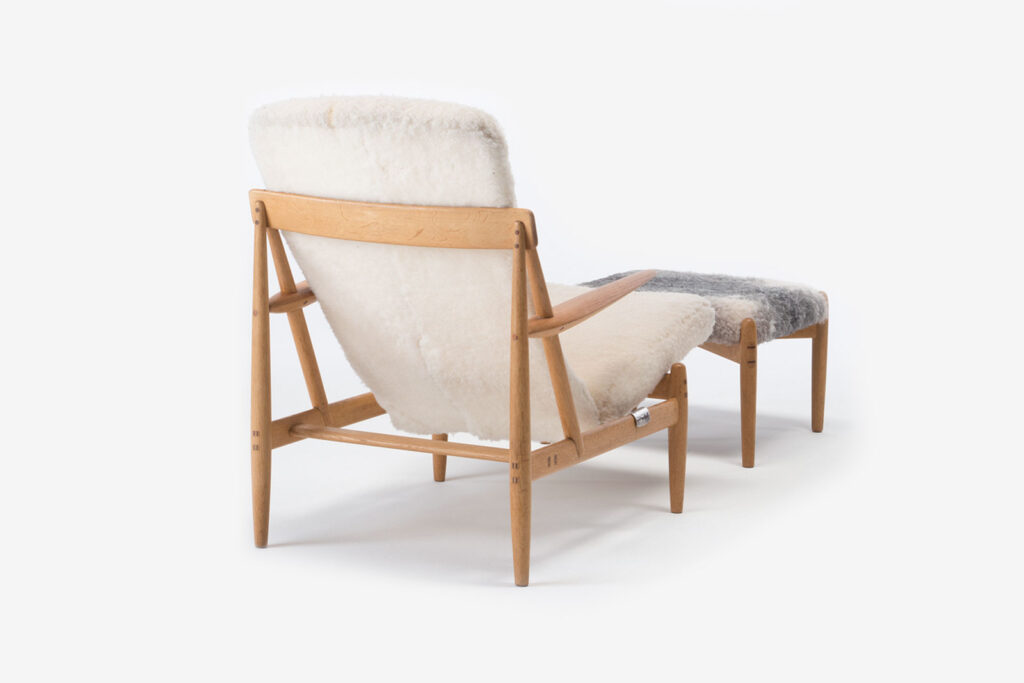
Episode 8: It took me two years to finally pay off the debt using manuscript fees and lecture fees, but it was a painful memory.
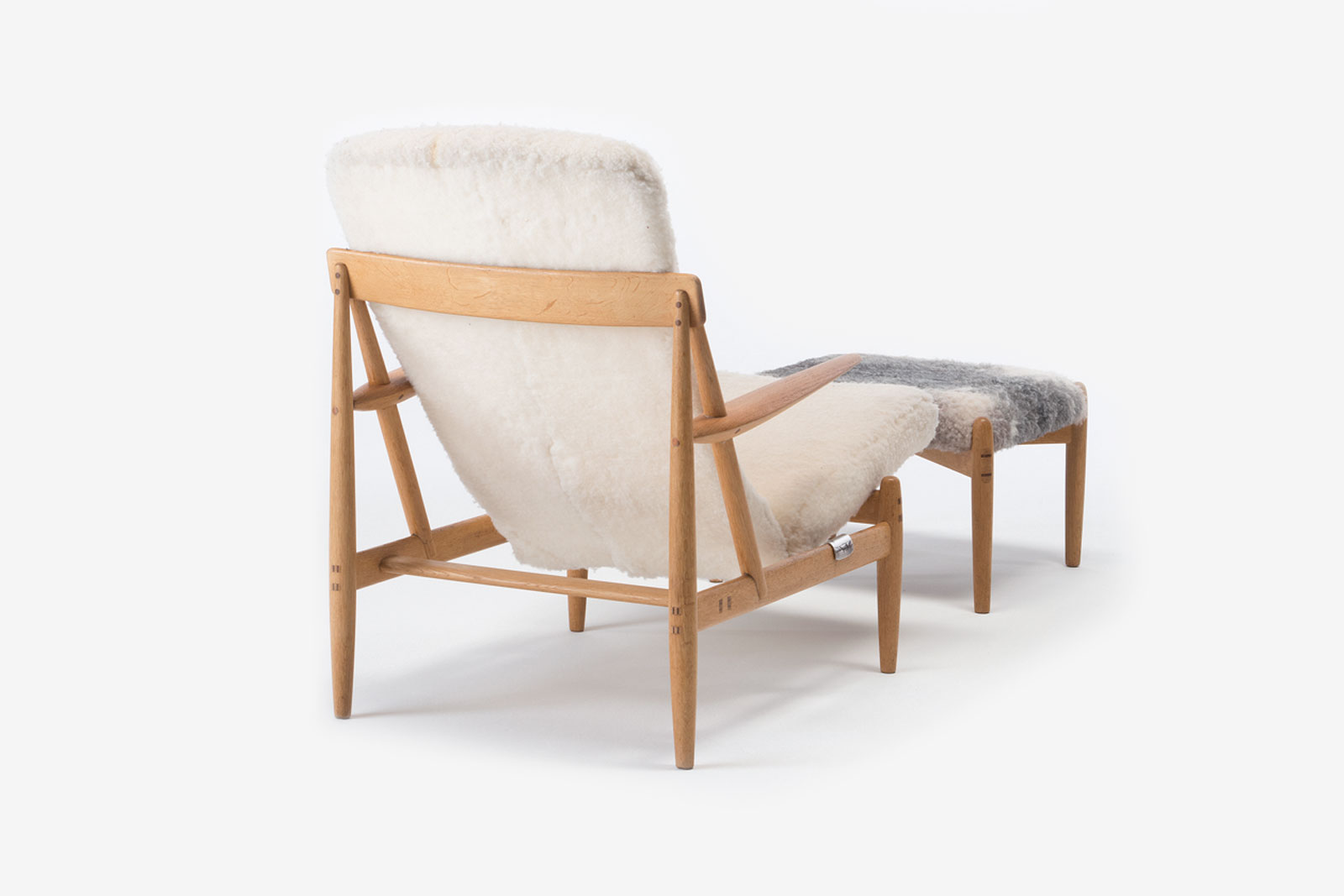
Bendt Winge
Easy Chair & Ottoman 1958 – 1959
Among the Nordic chairs in Oda Collection, this is a relatively rare Norwegian piece. It features an elbow design reminiscent of corners and the ability to change the angle of the back and seat by moving the metal fittings on the frame. However, due to problems with its structure, it was never mass-produced, and it is thought that this one set of prototypes, made in his own workshop, is probably the only one left in the world.
I found it at the “Norwegian Icons Exhibition”
held in Daikanyama, Tokyo.I happened to hear from an acquaintance that I could see Norwegian furniture so I decided to go there. When I saw this easy chair at the exhibition, I immediately remembered that it had been featured on a full page in the 1950s furniture magazine Mobilia. It was a beautiful chair in the photo, but when I saw it in real, I was even more impressed by it, and I knew I had to preserve it for the future design museum. The exhibition was a traveling exhibition, and items were not sold here would be sent to New York, so I had to make my decision immediately.
However, the price card attached to the chair had the number “? million yen” written on it. At that time, I had retired from my position as a specially appointed professor at Tokai University and was living off of my writing, lectures, and TV appearances. My retirement allowance from the university had been cut in half due to the payment of a chair. So, I explained the situation to the person in charge and, as usual, asked for a reservation and came home. However, the next day I received a phone call from the person who said, “There is someone who wants to buy it right away with cash.” And seemed to be in trouble. In my case, it would be the end if I was told that (lol), so I answered, “I have no choice. I’m giving up.” I was disappointed, but a few days later I received a phot call again, this time saying, “I talked to the owner, and he said it would be better if Mr. Oda bought it. He said he wouldn’t mind splitting it up, so as he promised at the beginning. I’ll keep it for you.” While I was happy, the painful payments began. I had no choice but to pay it off with the money I worked for, and it took me two years to pay it off. This is the chair that I remember having the most trouble paying for in my purchase history.
Norwegian furniture has
a primitive uniqueness.Most of the furniture in my collection comes from Scandinavia, with about 900 pieces from Denmark alone, but only about 30 pieces from Norway. One of the reasons may be that it is the only Nordic country that I have not actually visited. Norway is a geographically isolated country, where you have to take a boat from the depths of a fjord bay to the open ocean to reach the neighboring fjord, making it difficult to be influenced by European countries. I think that’s why primitive designs have been passed down for so long. Its unique traditional flavor is reflected in, for example, the Viking ship Oseberg, which is famous for its advanced wood technology, and the stave church, which is a UNESCO World Heritage Site and has a wooden structure that does not use nails. However, it seems that they were trying to follow Denmark when it came to chairs.
This chair also shows Danish influence. The structure and design are very similar to the “Hunting Chair” introduced by Børge Mogensen in 1950. Maybe the redesigned it based on that. Around this time, outstanding designers such as Alf Sture (if you have the 2023 Scandinavian Design Exhibition Catalog, p.43), Sigurd Lesser (p.44), and Adolf Löling & Rolf Rastad (p.45) appeared in Norway., which released beautiful chairs that were influenced by Danish design in a good way. This created a harmonious design throughout Scandinavia, which came to be known as “Scandinavian Harmony.”
Problems that could only understand from the real chair.
Perhaps that’s why it couldn’t be commercialized.The seat angle of this chair can be adjusted depending on the position of the metal, and it is also removable. However, after actually using it at home, I realized that it was quite difficult to use. Although I thought it was dangerous to sit, I continued to use it for a while because I wouldn’t know until I actually tried it. You can only understand the appeal and problems when you see it in real. You can’t really understand it in virtual reality.
The first problem was the joint between the leg and the pierce. Since the tenon is driven perpendicular to the wood grain of the frame, there is a possibility that it would crack if force is applied with a wedge. As a general rule, the tenon should be parallel to the wood grain. If the frame under the seat has only one through hole, its rigidity will be weak. For the diagonal parts that support the back, it is better to use the “Aigaki such as halving” method, in which the joints of both sides are cut out and fit together. Prototypes are usually made with 5 or 6 chairs, at least 2 chairs, but the owner said, “This is probably the only one in existence,” and the others probably broke for the reasons mentioned above.
The structure was found in more detail when a Norwegian furniture manufacturer asked if they could draw up a drawing for mass production. Because usually it has done it opposite. When they inserted a needle into the seat of the shearling and probed the base, we found a steel pipe with a belt wrapped around it. At the time it was created, there were probably no pipe bending machines in Norway yet, so it must have been painstakingly bent by a blacksmith. I checked its position and thickness and drew a drawing. Drafting drawings is a very meaningful task that allows us to obtain numerical values for things that were only vaguely visible. I drew the front view, back view, side view, and floor plan, and the more I drew them, the more I realized their beauty. By doing so, we will be able to understand in more detail what it has in common with “Hunting Chairs.”
This “having both types of chairs” is the important meaning of Oda Collection. Analogy (making analogies through morphological resemblance/comparison) is very important in research, as how originality is achieved within similar cultures can lead to the evolution of design. In the case of this chair, I tried redesigning it and changing the angle of the seat. That’s why I thought it was a chair that should be passed on to future generations.
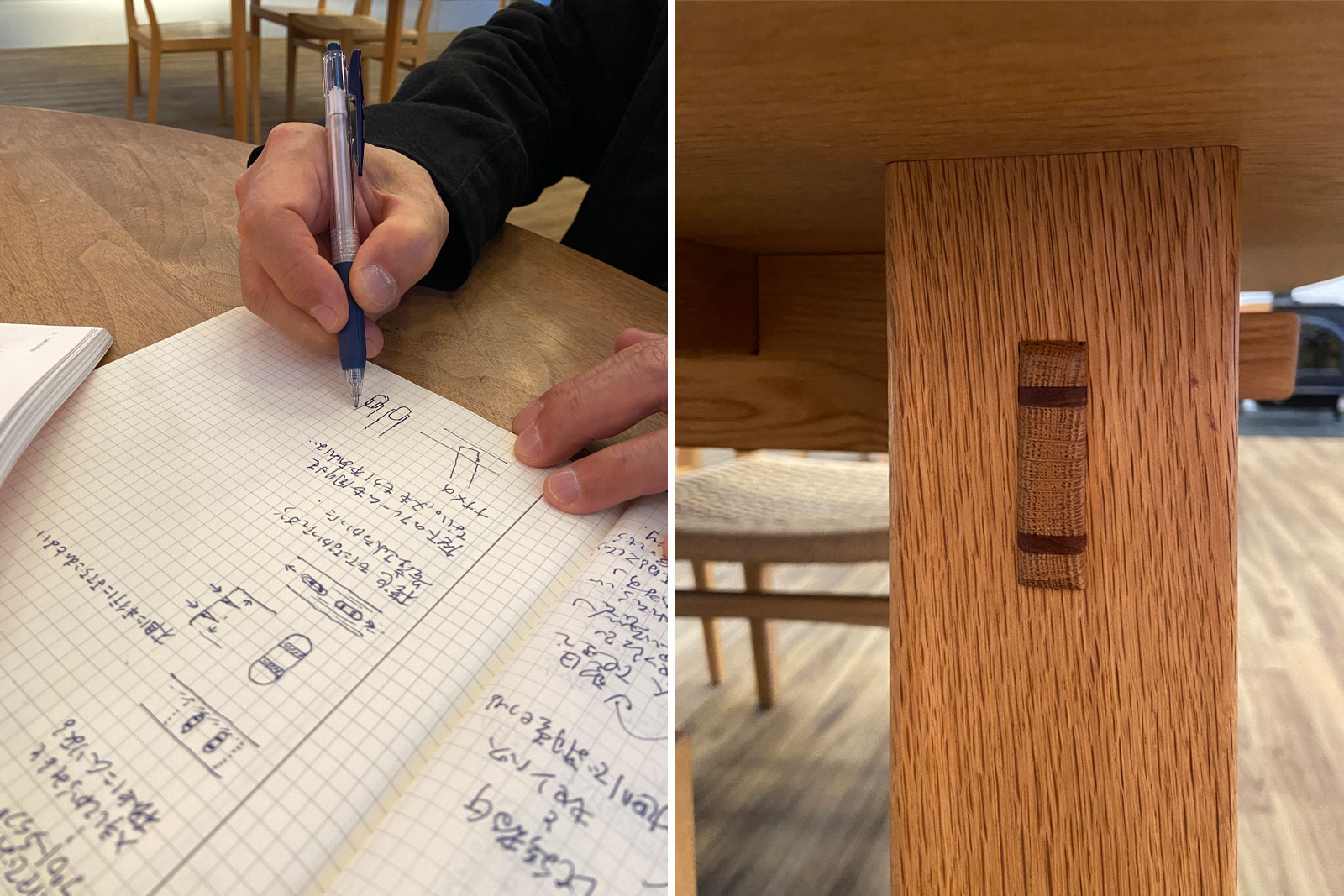
Left: Mr. Oda explains about the joint by drawing a diagram in my notebook. / Right: Tenon’s parallel to the wood grain. This is the original connection. My fate with Asahikawa Furniture began
at the first International Furniture Design Fair Asahikawa, IFDA.Since the topic of Tokai University came up, I would like to talk a little about the time when I moved from Osaka to Asahikawa and started working at Tokai University. The impetus for moving here was an encounter with Mr. Minoru Nagahara, the founder of Conde House, who was a driving force behind Asahikawa Furniture. It was at the “180 Danish Chairs Exhibition” at the “World Design Expo” in Nagoya, which I introduced in the previous column. While I was not in the gallery for personal reasons, Mr. Nagahara visited and left a business card with a note that said, “If you ever come to Hokkaido, please come visit my office.” Coincidentally, three or four months later, I received a job in Hokkaido. After I finished reporting in Ashibetsu City, which is near Asahikawa, someone from the Interior Center came to pick me up and took me there to a conference for the International Furniture Design Fair Asahikawa, IFDA. It was held in a hotel.
This fair has been held every three years to date, and will be held for the 12th time in 2024, making it a global design event. The first event was planned to commemorate the 100th anniversary of the founding of Asahikawa City, and was very large-scale and spectacular. It is said that an exhibition of masterpiece chairs will be held at the event as part of the project. When I was shown the list of exhibitors, I saw that there were items that were difficult to obtain, such as those that were only available overseas. So, I suggested, “If it’s the 100th anniversary of our founding, why not collect 100 chars by 100 designers from the past 100 years?” I have 75 chairs, and the other 25 can be borrowed through from friends. This exhibition became the fate between me and Asahikawa Furniture.
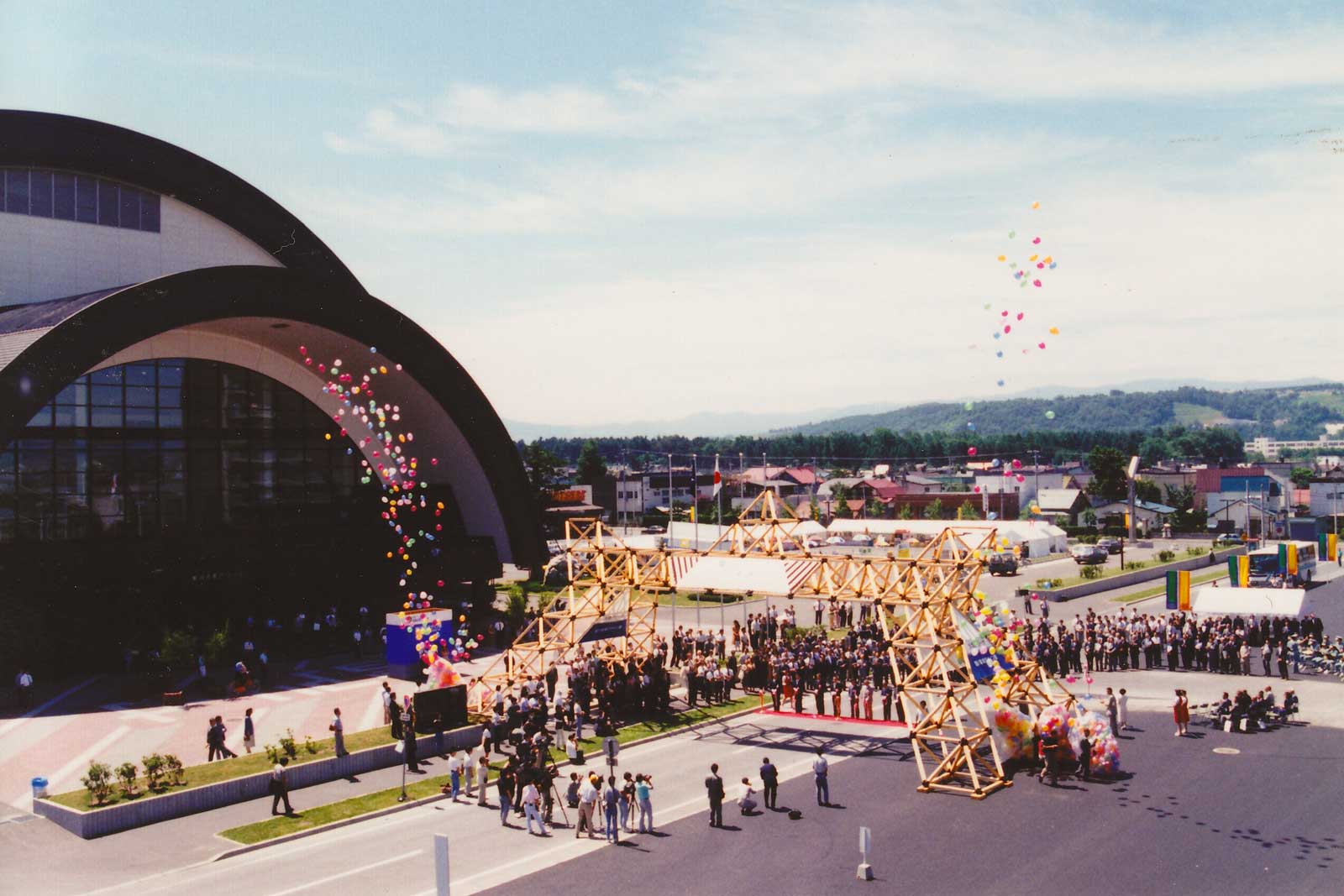
The first International Furniture Design Fair Asahikawa was held in 1990 to commemorate the 100th anniversary of the founding of Asahikawa City. 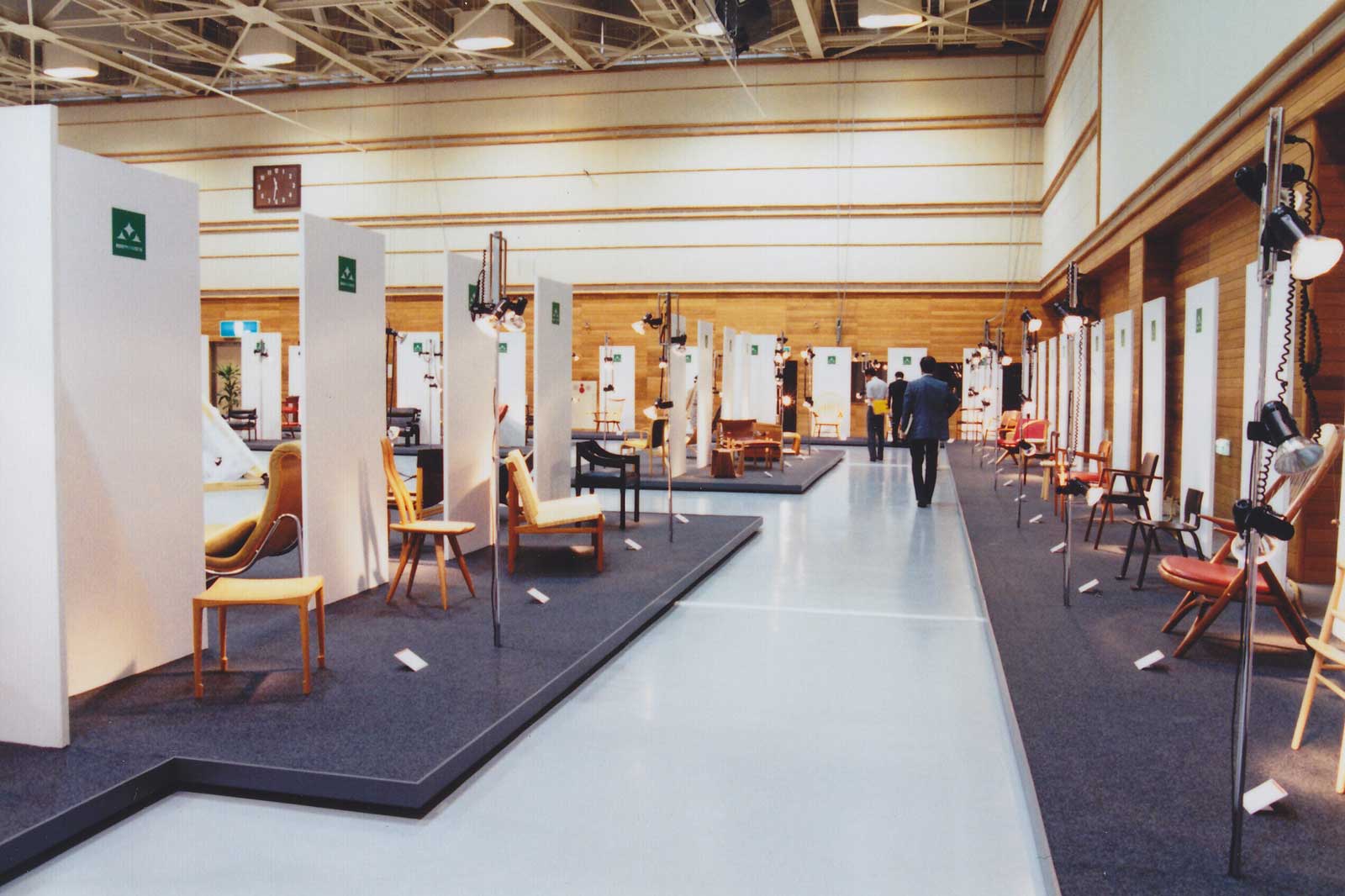
“100 Years, 100 Artists, 100 Pieces of Wooden Furniture Asahikawa”. This is where the fate between Mr. Oda and Asahikawa Furniture began. 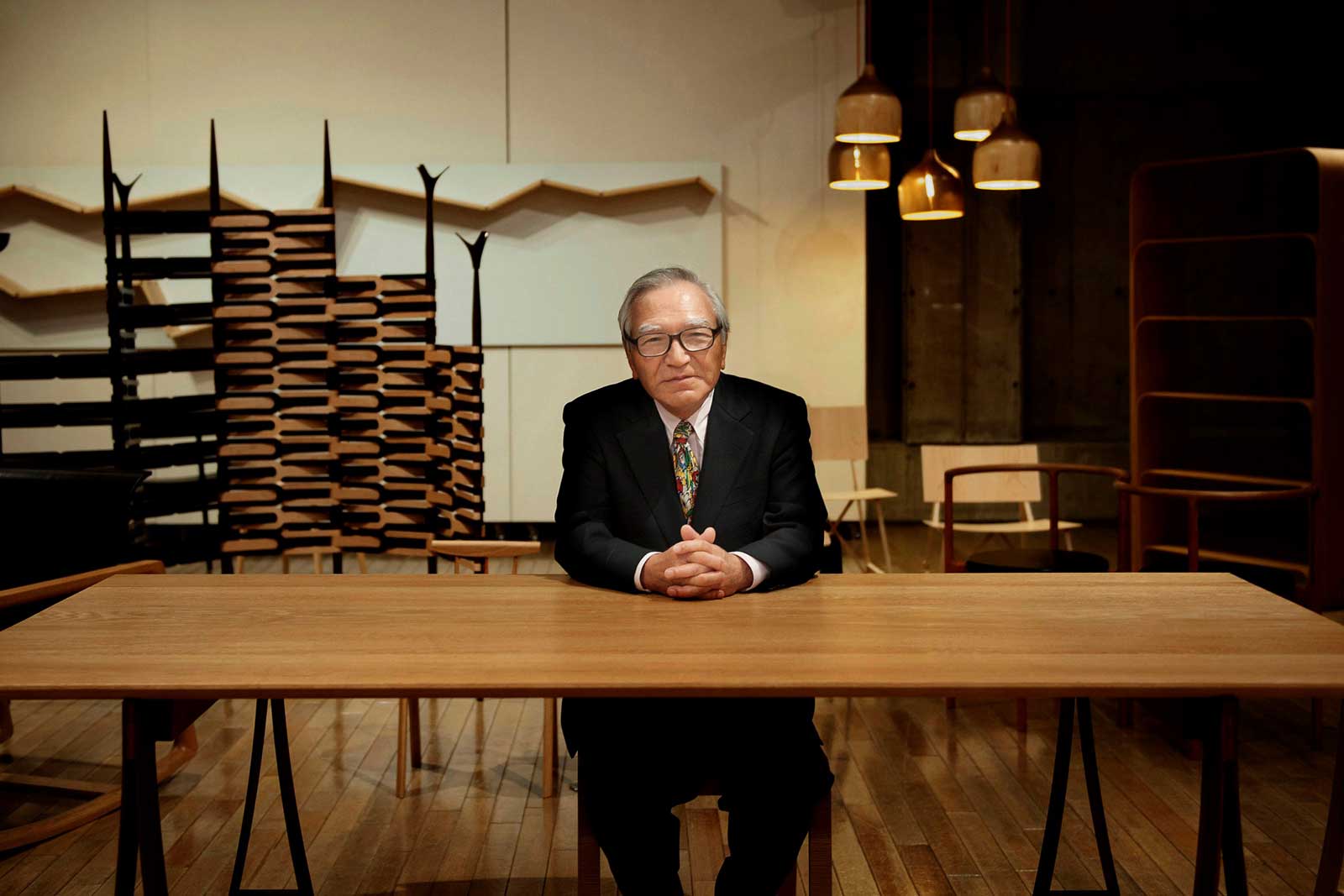
Minoru Nagahara, who led the Oda Collection to Asahikawa. He was always thinking about the future of his hometown and young people. I was accepted into a professorship at Tokai University’s Asahikawa Campus,
which made it possible to move to Hokkaido.The Design Fair was a success, and Mr. Nagahara and I often talked after the fair. When Mr. Nagahara learned of my plight, I had reached my financial and physical limits due to the storage space for over 800 chairs and the filming work that cost 200,000 yen every week. He said, “Why don’t you come to Asahikawa with your chairs? And let’s make a design museum in Asahikawa”. However, there were too many challenges. I was 47 years old at that time, have a family, run a design office, and have some important clients. I have also served as a part-time lecturer at Osaka University of Arts, Saga Art University, and Kobe Gakuin Women’s Junior College, as well as at Osaka College of Art and NHK Cultural Center, so I had to retire from all of those positions. But I knew it was impossible to continue with colleges, and in the end, I made a big decision in my life.
The biggest driving force behind the move was, of course, the dream of “building Japan’s first design museum,” but in order to do that, I first had to be able to live there. At first, Mr. Nagahara didn’t think I would be able to leave Osaka, and apparently, he only intended to keep my chair in Asahikawa, but I’m a researcher. I can’t do research unless I’m with the chair. To do that, I needed a job in Asahikawa. It was Mr. Nagahara who heard my wish and invited me, “There seems to be a job in the Department of Design at Tokai University, so why don’t you become a professor?” I was afraid as to whether I could do it, but thanks to my experience teaching in Osaka, I received a heartfelt letter from Professor Jiro Oya, who was the head professor of the Department of Architecture at the time, saying, “I would love for you to come to Asahikawa.” That made me decide. That’s how I was hired as a full-time professor in the Department of Design at Tokai University’s Asahikawa Campus, where I worked for the next 21 years. (The last three years as a specially appointed professor).
I say this now, but at that time I didn’t even know where in Hokkaido the town of Asahikawa was (lol). When I decided to move here and went around to say goodbye to the people who had helped me, an elderly woman called out to me and said, “You are going to Hokkaido…I’m sorry for your loss…” (lol) That’s how Hokkaido was so far away for many people in Kansai.
In 1991, one year after the design fair, Mr. Nagahara’s ideas and leadership led to the establishment of the “Oda Collection Organization” centered on the Asahikawa Furniture Industry Cooperative. Thanks to many members, we were able to secure the transportation and storage costs for the chairs, and now we have a plan for photography and an exhibition, and we have opened an exhibition space called, “Chairs Gallery” at JR Asahikawa Station. However, at that time, the public’s awareness of design was not as high as it is now, and galleries were not open to visitors unless they pay a fee. Thirty years have passed since then, and this area has changed significantly. It feels like a world apart. Landscape conditions such as the design of the area around Asahikawa Station and the beauty of the town have been met. I think there are many ways to develop by taking advantage of this perfect size and ease of living.

The Tokai University Asahikawa Campus opened I 1972 as the Tokai University College of Technology and greatly contributed to the revitalization of local industry. The school closed in 2014 and was taken over by the Sapporo campus. December 5th, 2023 Centpure (Higashikawa)
Interviewer: Kano Nishikawa
[ After the interview ]
Tokai University Asahikawa Campus is a very memorable university for me. My brother graduated from the Department of Architecture and became an architect, and I was introduced by Professor Oda and served as a part-time lecturer on advertising theory for 14 years. People who studied architecture and design at Tokai University are working out not only at the design offices we have relationships with, but also at furniture manufacturers and housing manufacturers. I think that the power of these young people is a big part of Mr. Oda’s “feeling that the last 30 years have been a lifetime apart”. The university’s closure in 2014 was a tremendous loss for the Asahikawa city. Minoru Nagahara was the leader of the citizen movement that arose immediately after the crisis. Supported by public opinion, Asahikawa City is finally making the private Asahikawa University a municipal institution and creating a new faculty, but the content is far from the manufacturing and design education that was originally aimed at. This is the biggest problem at the moment for Mr. Oda and everyone involved in furniture and design.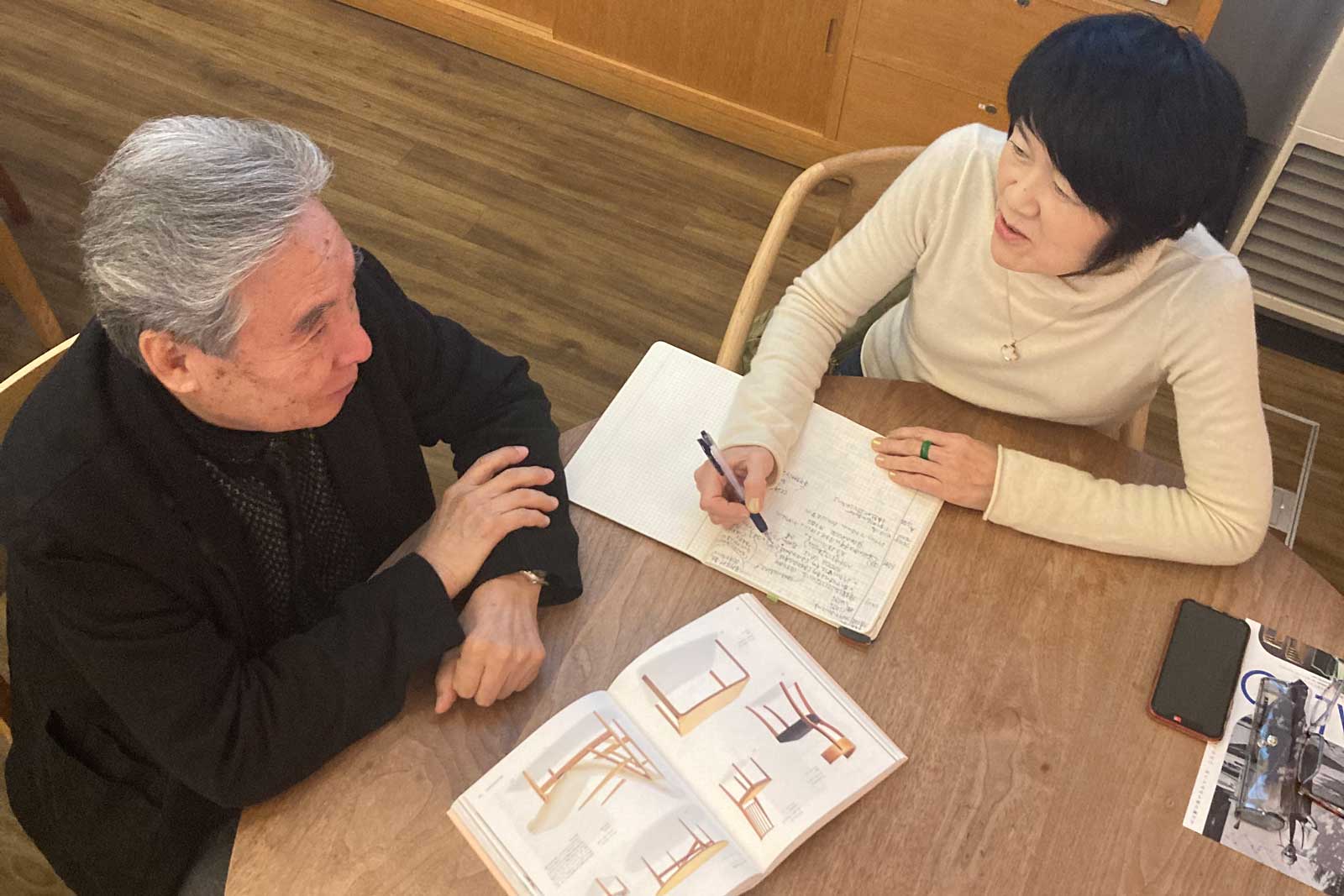
Copywriter Kano Nishikawa
After working at a design office in Tokyo and Sapporo, I started working as a freelancer in Asahikawa in 2001. Until now, I have been involved in the production of advertisements for local companies and organizations, including Asahikawa Furniture. I have known Mr. Oda for about 30 years through my work. -
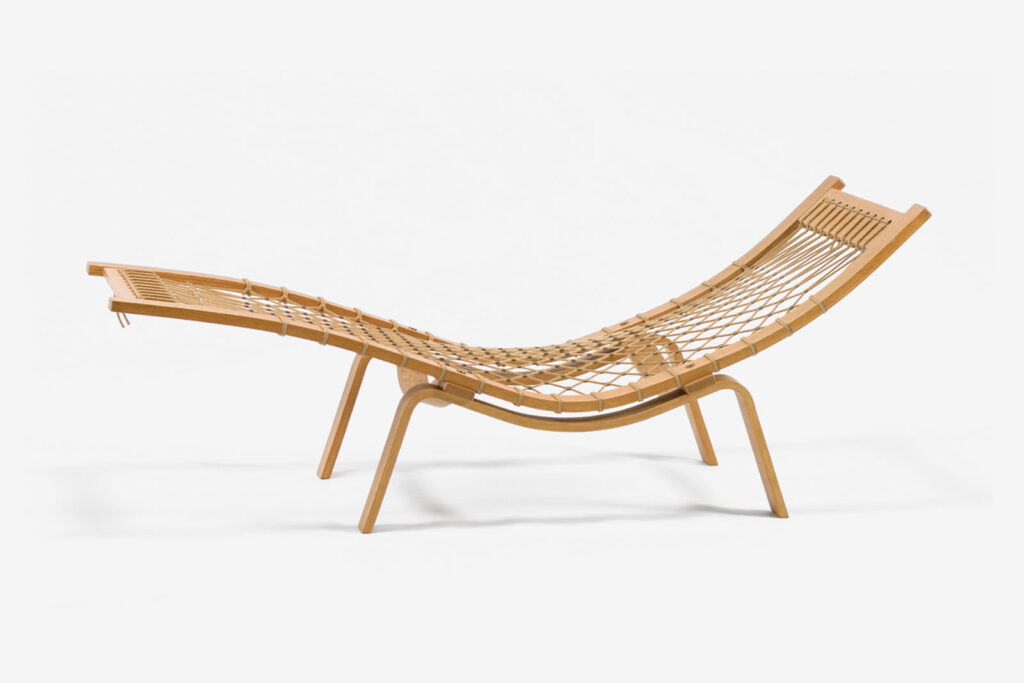
Episode 7: “There is a Japanese man who is reevaluating our country’s chairs.” A connection with an elderly couple connected by news coverage in Denmark.
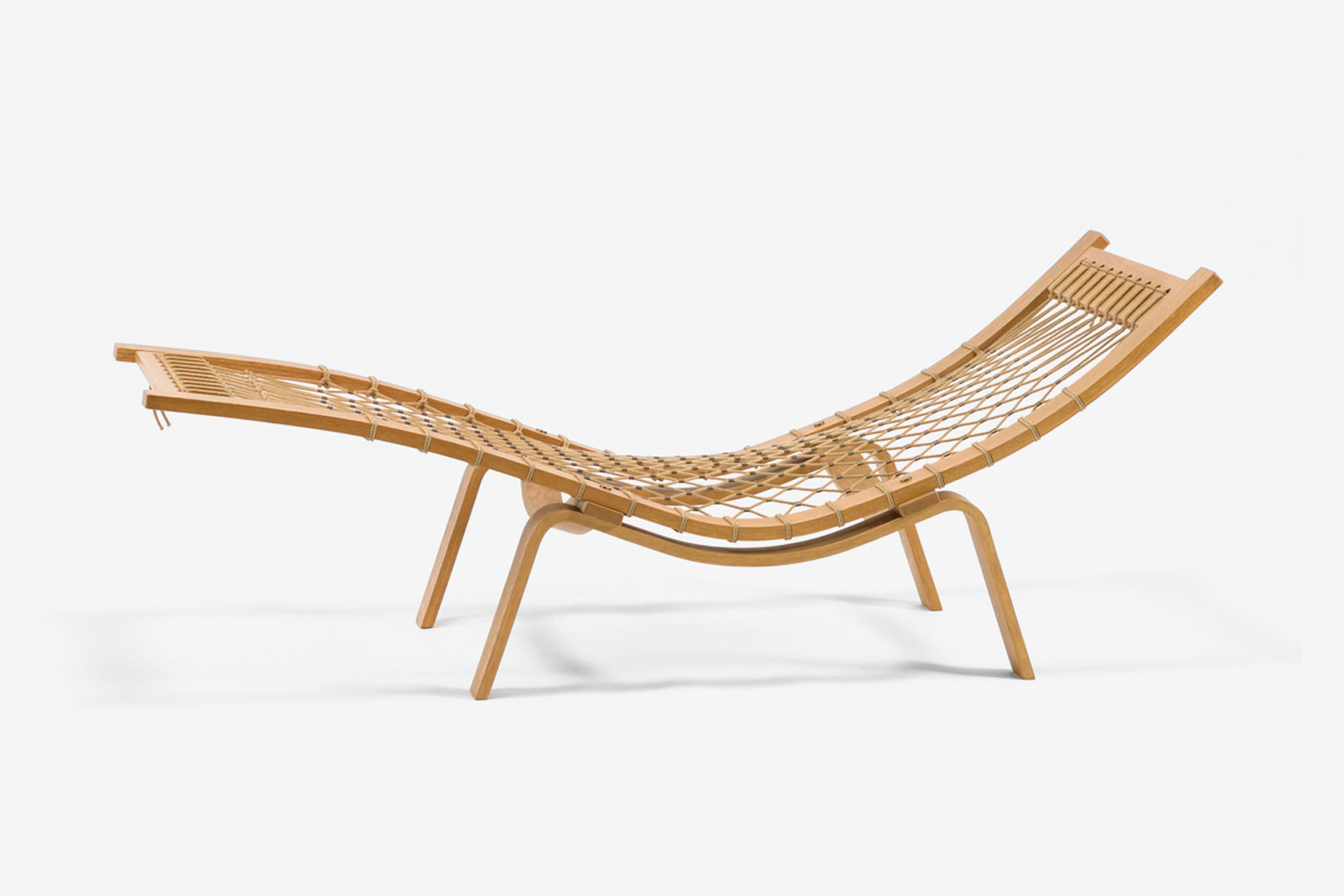
Hans J. Wegner
Hammock chair, 1967
It is one of the seven chaise longues announced by Wegner, and as its name suggests, it has a structure that holds the body with a net-like rope. Like the “Hoop Chair” introduced in Episode 2, the rope is woven with metal clips that do not form knots, making it very comfortable to sleep on. At the time, the wood was made of oak, but now PP Møbler uses ash.
While actively collecting chairs, this is a piece that
I thought I absolutely had to keep.In 1980s, the number of chairs increased rapidly, and I think there were about 20 to 30 chairs by Wegner’s works alone. Since Wegner did not design many chaise longues, I had decided to have all seven types, but the one I had a hard time finding was the Hammock chair. The molded plywood frame has a beautiful curve, and the holes on the sides are recessed to allow the net to drop under your weight. Like all Wegner chairs, this one hits the sweet spot the moment you lie down. Among them, the Hammock chair is a very comfortable chair, and I remember that it was used in the Wegner House by the window in the living room facing the terrace, with a piece of sheep’s fur on it. The other day, I purchased a “Bear Chair” at the request of my family. It features sturdy elbows that allow you to hang it in any way you want, such as sitting sideways or diagonally, and it fits snugly into your body in any position. Even families who normally use cushions and headrests to find the comfort that best suits them are using this chair as is saying “It’s better without anything.”
I really wanted it,
but I couldn’t get it no matter what.This was when I co-managed a design office in Osaka with a friend and worked day and night to pay for the chairs. I visited Getama in Denmark, which was manufacturing Hammock chairs at the time, and asked them if I could buy one for my research. I saw that there were four hammock chairs in parts in the back of the warehouse, but at that time, the company president was the top employee, and he turned me down saying, “I don’t have the authority to make decisions.” When I saw the real thing in front of me, I couldn’t get it, so I returned home disappointed. Still, I couldn’t give up, so I kept sending letters for a year, but they still wouldn’t sell me. After a while, the hammock chair was put up for sale by Arne Brunn Rasmussen, a major auction house known for selling many masterpieces. This time I thought for sure, I participated in the bidding, but the price went up in the blink of an eye, making it far beyond my reach, and I couldn’t win the bid.
It spread throughout Denmark that
“There is a Japanese man who is reevaluating our country’s chairs.”The hammock chair came to me in an unexpected way four or five years later, and it probably all started with the World Design Expo held by Nagoya City as part of its 100th anniversary commemoration project. Among them, the “180 Danish Chairs Exhibition” was held using my collection. During the five-day exhibition period, the number of visitors far exceeded expectations, with some sitting on the floor and intently looking behind the chairs, others bringing their own lunches and staying all day from opening to closing and some people visited the museum for 3 days in a row. There was even a high school where a teacher led an entire class to see the exhibition, and its popularity made it big news in Denmark.
POLITIKEN, a national newspaper similar to Japan’s Asahi Shimbun, published an article about the chair exhibition in a 30-page spread. A total of 14 to 15 media outlets, including local newspapers, covered the story. There is no doubt that these reports helped make my name and my efforts known to the Danish general public. The Japanese man is reevaluating our own furniture culture, which even the Danish had abandoned at the time. This became a hot topic, and a traveling exhibition called, “Finn Juhl Memorial Exhibition” was subsequently held in the first floor lobby of POLITIKEN. As I’ve said many times before, keep holding on to your dreams without wavering and spare no effort. Someone is definitely watching it.
Call came from the Danish Embassy in Tokyo,
“A fax has arrived from Denmark addressed to Mr. Oda.”Four or five years after the aforementioned auction, I received a phone call from Mr. Shinji Araya from the Danish Embassy (who I later met again as an employee of Louis Poulsen). I received a fax from an elderly couple in Danmark asking me to purchase a chair for them. I was surprised to see the paper that was forwarded to me, and it said, “I would like to give away my hammock chair.” “I’ve used it with care, so I’d rather have Mr. Oda in Japan buy it than sell it at auction for a high price to a stranger.” The asking price was also written there. Since it was an amount that I could pay immediately, I told the embassy to let them know I would send the money immediately. In this way, I was finally able to add my long-awaited hammock chair to my collection. You can see from this series that I Have had many such good fortunes in my research career. I am grateful that the activities that I have continued to do steadily have permeated the world in various ways, such as the report by Politiken that I mentioned earlier.
Luck comes when you are pushed into a corner (laughs).
There was a surprise at this year’s Scandinavian exhibition.“Scandinavian Design Exhibition” was held at Takashimaya, Osaka in August 2023. On the same floor as the event hall, there were several vintage shops selling Scandinavian items. Among them was “Lystig” which I mentioned in this series. Pre-exhibition preparations continued until late at night, and when I took a quick peek during a break, I saw a dove-shaped bowl from the Royal Copenhagen “Tenera” series that I had been looking for. I went to Lystig the next day as soon as it opened, and asked the owner, who I have known for 25 years, to reserve the bowl and the rimmed mirror. Tenera is a popular series developed by six female designers in their 20s, led by Nils Thorsson, and is characterized by elegant blue painting. Oda Collection also has about 50 items, including candle stands.
The surprise happened at another vintage shop. At that store, I found a rare chair designed by Mr. Wegner when he was just starting out, which I don’t even own, and a piece from the late 1960s. The owner has also known me for 30 years, and I immediately asked him to reserve it for me. I added the following words: “Academic price please” laughs. The owner replied, “I am fully aware of this.”
After the exhibition ended, I received an estimate by fax to my home. When I looked at it, I saw that the price of the chair was “? Yen”. My guess is that it should cost between 700,000 and 800,000 yen for two legs. I believe that the owner, who understands my past research activities and knows that I have no intention of reselling, supported me despite that hardship I had endured.
August 30th, 2023 Centpure (Higashikawa)
Interviewer: Kano Nishikawa
[ After the interview ]
Mr. Oda moved to Hokkaido alone in 1994 on March 28th, when there was still snow on the ground, and he lived in an apartment in the center of Asahikawa City. I have also been invited to tea with my husband and attended a design tea party with Tokai University professors. There was even one lucky episode in the move. Mr. Oda set up a 4-ton long truck from Osaka and headed to Asahikawa, but there was so much baggage that there was a backlog, so he arranged for an additional 10-ton truck. After arriving in Asahikawa, he realized that the shipping fee was more than double that of a 4-ton truck. Mr. Oda, who was at a loss, unpacked the package and began arranging the materials by author. Then, an envelope pops out between the documents…(It’s like a drama) there were several 10,000 yen bills inside. With that money, he was able to pay for the 10-ton truck, and the move was completed safely. Mr. Oda, the god who shows up when he is in trouble, please lend it to me too. Laughs.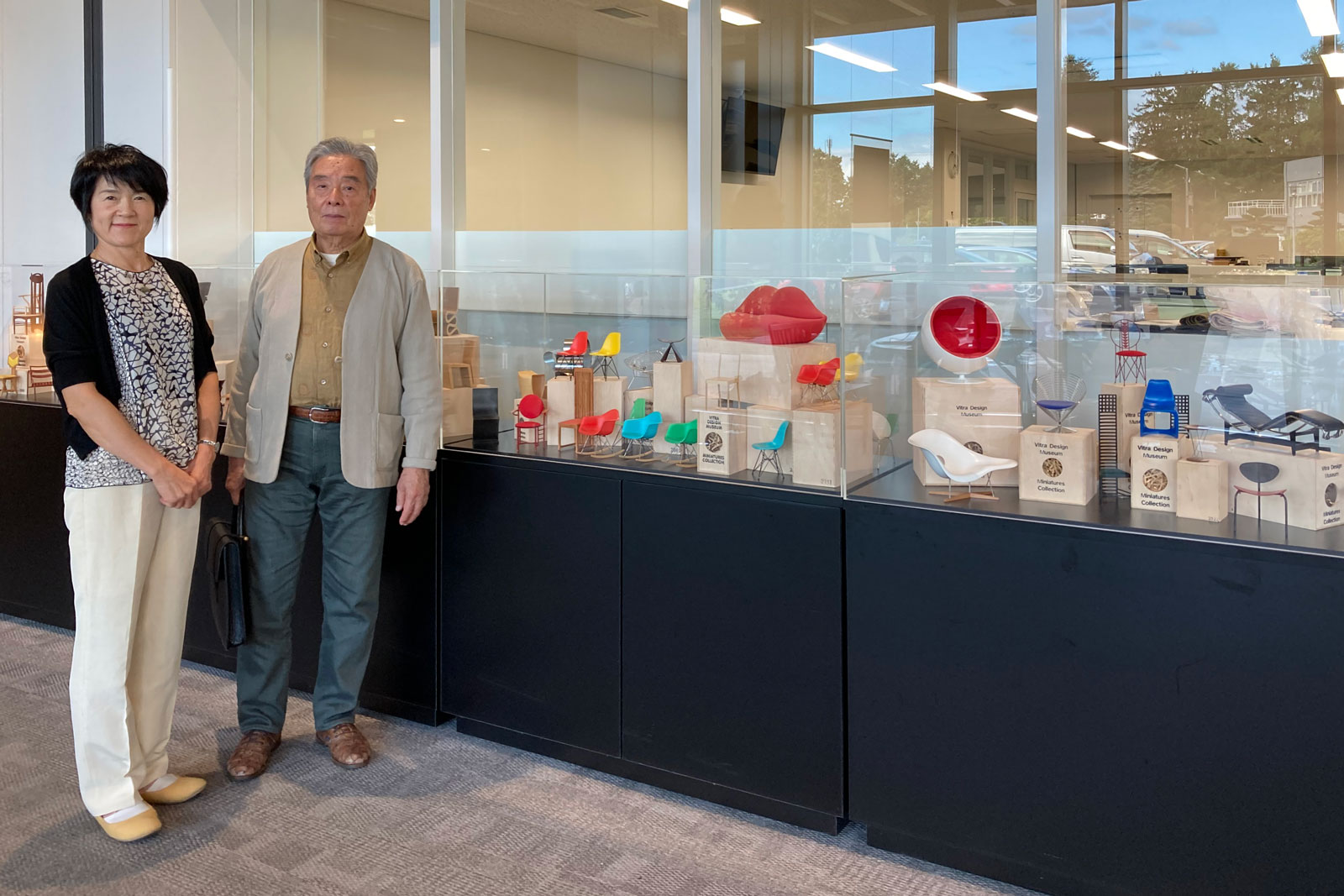
Masterpiece chair 1/5 miniature collection owned by Mr. Oda. It is on permanent display at Cent Pure 2. Copywriter Kano Nishikawa
After working at a design office in Tokyo and Sapporo, I started working as a freelancer in Asahikawa in 2001. Until now, I have been involved in the production of advertisements for local companies and organizations, including Asahikawa Furniture. I have known Mr. Oda for about 30 years through my work. -
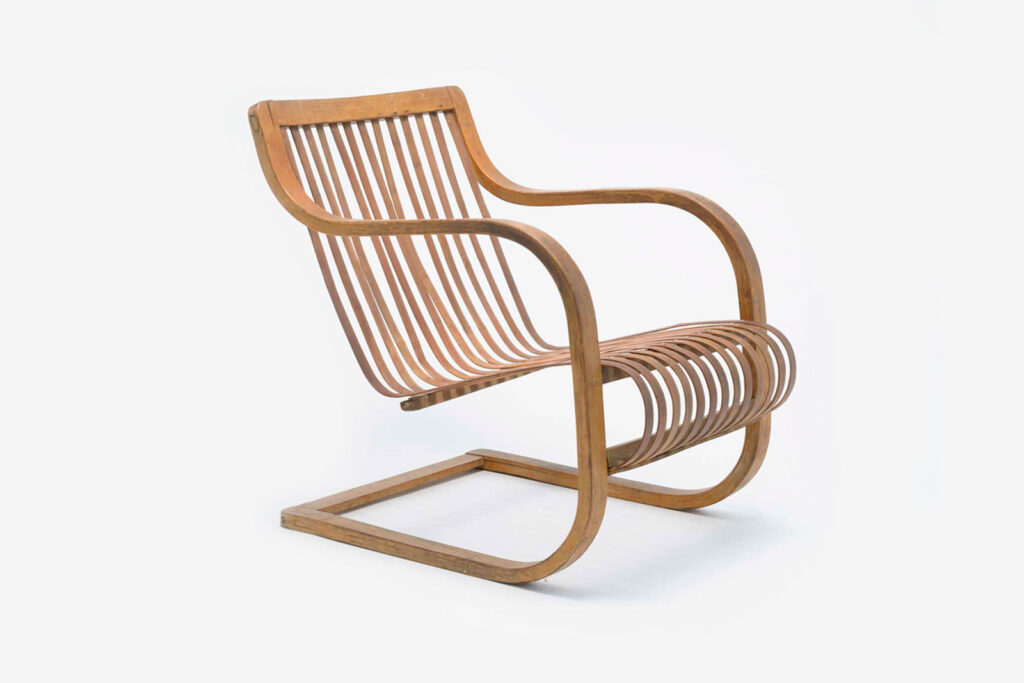
Episode 6: I saw a chair at someone’s house more than 25 years ago and I couldn’t say I wanted it when I left.
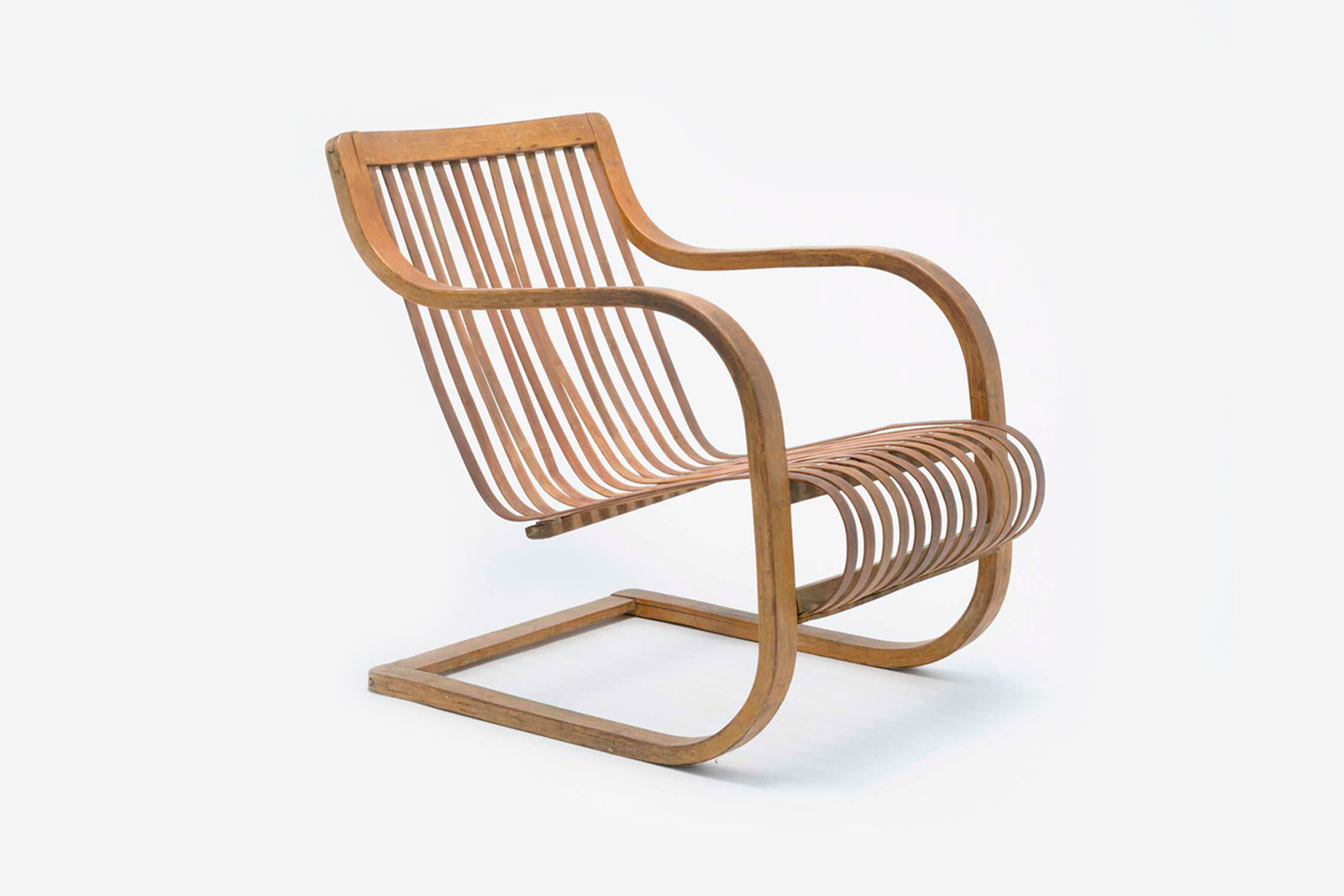
Ubunji Kidokoro
Bamboo Chair (1937)
A chair with a cantilever structure (cantilever, protruding) that utilizes the elasticity of bamboo. Long and thin strips of bamboo are arranged vertically from the back to the seat and fasted to the crosspieces on the back of the seat with rivets. The frame is also made of bamboo, and it is an eight-ply lamella-bent material (all piled up and bent in the same direction), which had never existed before. Some bamboo cantilevers were also made overseas.
A friend invited me to meet a man and
the man I visited who he was a “Forest King”.I visited him for the first time in 1994, shortly after I came to Asahikawa alone, and I think it was around the following year. There was Mr. S’s house in the town next to Asahikawa. When you enter the tree-lined road from the national highway, a wide tree-lined road with large trees on both sides continues for about 200m. I was surprised to hear later that this tree-lined street was also Mr. S’s property. Mr. S’s deceased father was a large landowner in the area, and his house had three ponds and he had a house for servant. When we visited, Mr. S was living in the house that the servant was using, but it was a very large house that I couldn’t believe it was for the servant’s house. The main building had already been demolished, but it is said that members of the imperial family stayed there, so there is no doubt that it was a mansion. By the way, Mr. S had graduated from the University of Tokyo, and it seemed that he stayed at the Imperial Hotel for four years while he was in school and went to school from there. There are wild people in the world.
When I visited for the second time,
I found a bamboo chair.Well, the episode starts from here. I visited Mr. S’s house again after that. When I contacted him, he was in good health despite his age, and was shown to his room and treated to coffee. Not only was the interior spacious, but it was also an advanced design for the time when ondol (underfloor heating seen in Korea and elsewhere) was incorporated. By chance, when I looked at the porch, I saw Ubunji Kidokoro’s “Bamboo Chair”. Moreover, two legs were lined up in a beautiful state. Actually, I already had one of these bamboo chairs at that time. Around 1990, when the collection exceeded 800, it was a gift from Ryuichi Nakamura, a professor at Kyoto City University of Arts and although I knew of its existence, it was the first time I had seen it in person. When I found the same chair at Mr. S’s house, I was really surprised to find it in this small town in Hokkaido. Of course, I wanted to say I wanted that chair, but I couldn’t say it and left.
May 2023,
I got a call from Mr. S’s daughter.And this spring, I got a call from Mr. S’s daughter who lives in Tokyo. She said, “After my father passed away, local people helped me cut the grass and took care of the inside of the house, but the damage to the building was so bad that I decided to demolish it. I heard you’ve seen our house before and there were two bamboo chairs. Could you take the two bamboo chairs that were there at that time?”. I immediately asked to see the house again. As I heard, it was crumbling everywhere and was in a dangerous state. The bamboo chair was still on the porch, and a small table was visible between the two chairs. Since the legs are made of laminated bamboo, which is exactly the same as the chair, it is probably a set. The top plate is covered with decora and the sides are made of aluminum. It may be around 1955. It is also possible that Ubunji designed it later. In any case, it was a precious thing that I had never seen before, so I was allowed to take it in together.
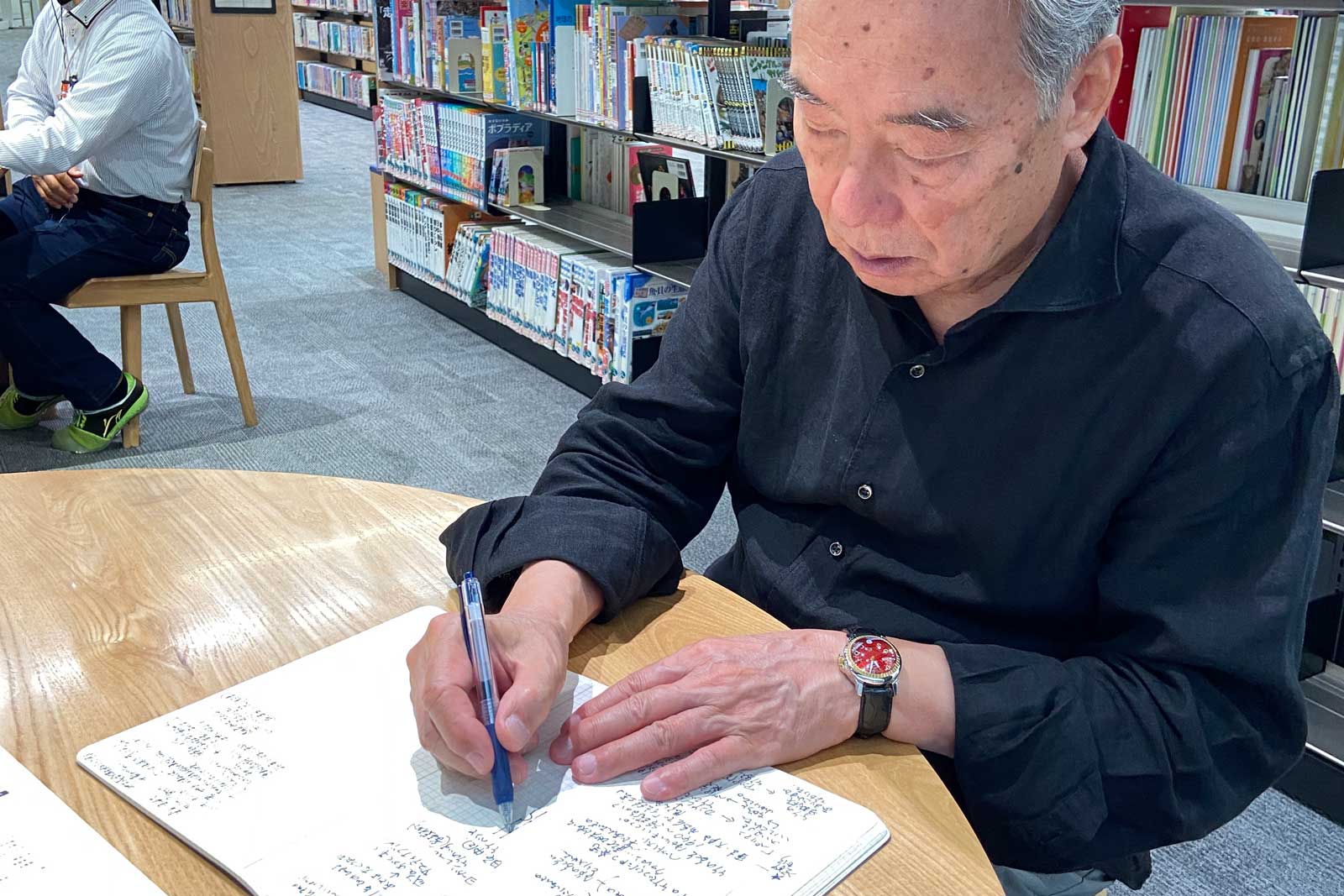
Mr. Oda is explaining the shape of the table in Mr. S’s house and how to join the bamboo by drawing an illustration. As for the bamboo cantilever,
Kidokoro was ahead of Perian.The cantilever structure was invented by Mart Stam of Bauhaus and spread, and architects and designers around the world worked on many chairs. French architect Charlotte Perriand was invited by the Ministry of Commerce and Industry, and she stayed in Japan for two years from August 1940 as a design and a craft instructor. At that time, the architect Junzo Sakakura, who studied at Le Corbusier’s atelier, and Sori Yanagi, a central figure in the Mingei movement, were in charge of guiding us. Perriand was surprised by the Japanese craftsmanship sites and the spirituality that lives there, and felt deeply something that Europe did not have. Perriand then began incorporating straw and grass into his furniture designs, and designed a bamboo version of Corbusier’s LC4, introduced in the first episode of this series. From the time he came to Japan until the end of the war, he seemed to have released several pieces of bamboo furniture. He also designed a chair very similar to this bamboo chair, and many people think that Kidokoro was inspired by that work, but in fact, it was Kidokoro who announced it first. Kidokoro Ubunji was an engineer at the Mitsukoshi Department Store’s Decoration Department (now the Construction Department). At that time, department stores were mainly engaged in the interior design of large passenger ships, while also producing original furniture that they designed independently. The Bamboo chair is probably a reference to the cantilever model introduced by Alver Aalto in 1932.
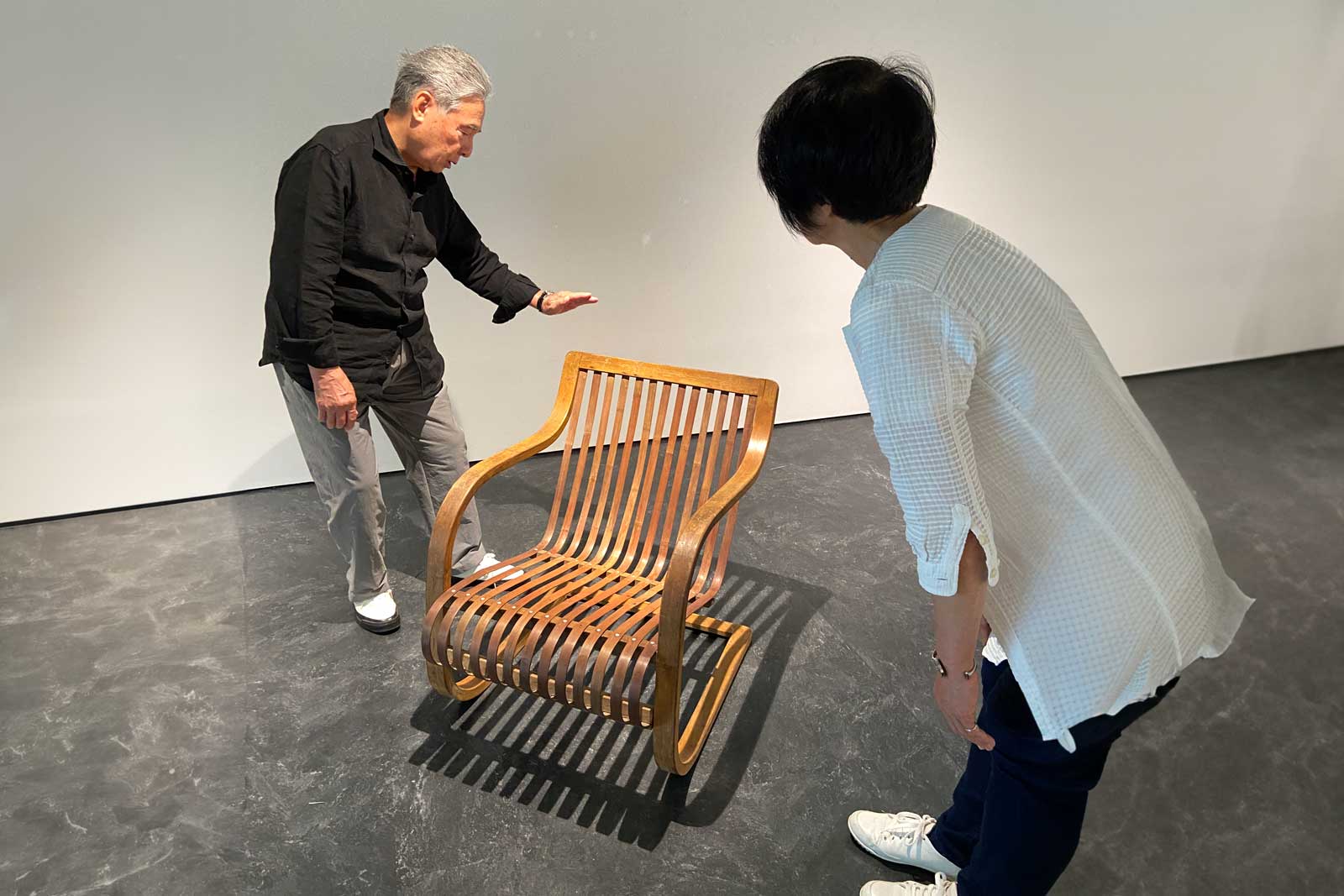
A bamboo chair that had just been brought into Higashikawa’s gallery in preparation for the exhibition. Mr. Oda explained molding and bending to me. In the collection,
there are about 30 to 40 Chairs of Japan.The standard of the collection is “things that I think should be left”, even for things of Japan. Among them are some valuable prototypes of Asahikawa furniture, but there are not many chairs of Japan. Japanese houses, where floor seating is the basic lifestyle, have ceilings of 2400 feet, so many legless chairs and low legless chairs that do not feel oppressive have been created.
I think that Japanese furniture needs to improve its design skills more and more. As for Asahikawa furniture, more and more manufactures are actively participating in joint development, but it is important to partner with excellent domestic and foreign designers and continue joint development, even if it means paying royalties. If executive can hone their intellect and sensibilities and build equal relationships with designers, collaboration will continue to expand. The same goes for craftsmen. Designers and engineers must be placed in a higher position than they are now so that they can speak on an equal footing. If this is reflected in the compensation, the treatment will be better and the quality of work will also improve. According to Kasper Pedersen, president of PP Mobler, who gave a lecture in Higashikawa the other day, all workers at the company are paid 6,000 yen per hour, regardless of age or gender.
In fact, the grandfather of the Oda family was also a researcher.
This is an aside, but the botanist Tomitaro Makino, who has become a hot topic in dramas, is from my hometown, Sagawa-cho, Takaoka-gun, Kochi Prefecture. And my grandfather was a researcher who collected plants with Tomitaro Makino where he was young. I heard that the Oda family was also involved in managing the mountains and land, and compiling the history of the town. Mr. Yokokura (also known as Utaki or Omitake-san), where Tomitaro Makino is said to have discovered a new species of Yokoguranoki, has an altitude of about 980m and a very beautiful shape. It is a familiar mountain that I climbed more than 30 times from my childhood to high school. The Oda family were descendants of Heike fugitives, and lived in a village called “Kusunokami” in Yokokurayama. My father was also born there. The Oda family has taken over the priesthood of Yokokura Shrine in Yokokurayama for generations, and my father was also a priest. Originally, I should have become a Shinto priest myself, but since I moved to Osaka for college, my relatives took over. But I inherited my gradnfather’s DNA as a researcher, so place accept that (laughs).
July 12th, 2023 Centpure (Higashikawa)
Interviewer: Kano Nishikawa
[ After the interview ]
This time, the interview started at 10:00 in the morning, and when we finished, it was just around lunch time (laughs). Mr. Oda said, “Let’s go to lunch” and took me to a nearby popular restaurant, “Chiba Shokudo.” While I was eating sable fish meal, I told Mr. Oda that my second son, who came with me to the “1000 CHAIRS exhibition” of the Oda collection held in the gymnasium of the Hokkaido Tokai University Asahikawa campus in 2002 , had a wedding last month. The photo is from the gymnasium at the time, and I happen to be sitting in the child chair by Marthe Stam, the inventor of the cantilever structure chair, which I took up this time. This kid is 27 years old. The number of Oda collections and my years with Mr. Oda should increase (laughs) That also should be expected.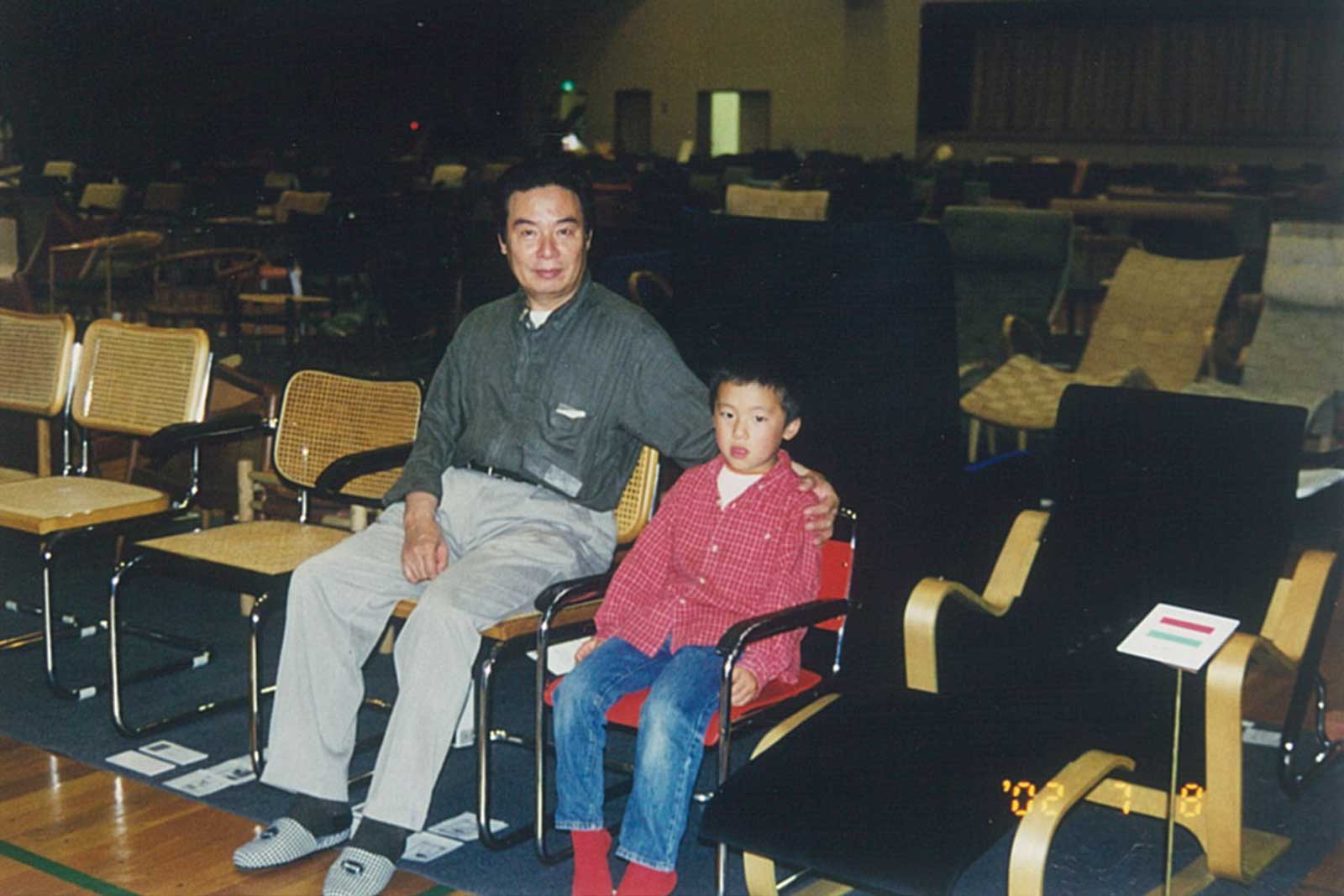

Copywriter Kano Nishikawa
After working at a design office in Tokyo and Sapporo, I started working as a freelancer in Asahikawa in 2001. Until now, I have been involved in the production of advertisements for local companies and organizations, including Asahikawa Furniture. I have known Mr. Oda for about 30 years through my work. -
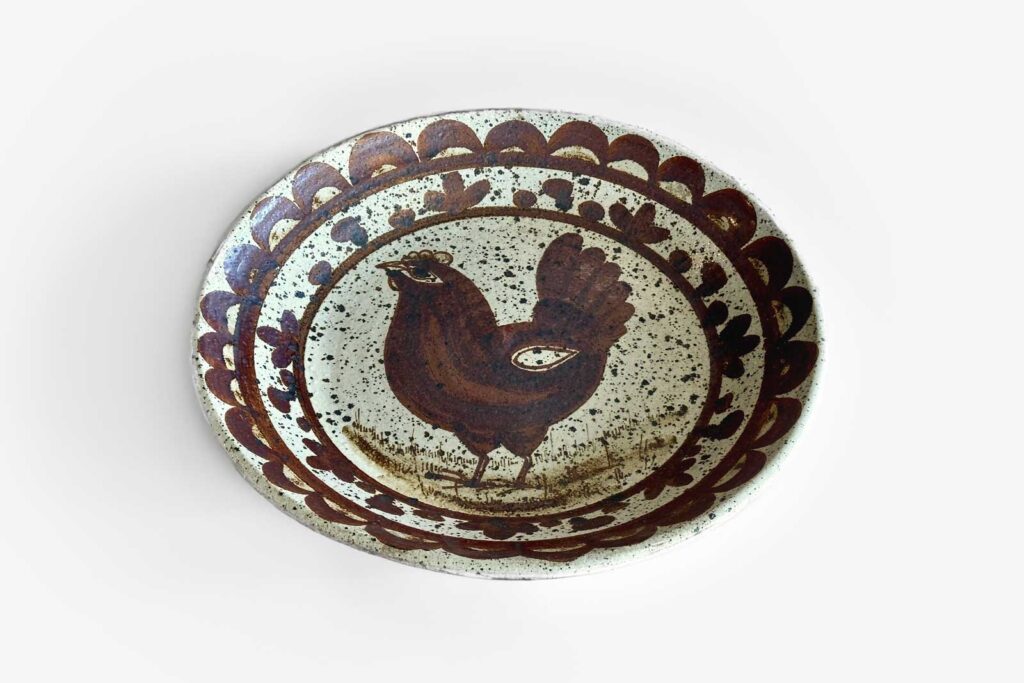
Episode 5: I happened to meet what I once gave up 30 years later. After all, God is watching.
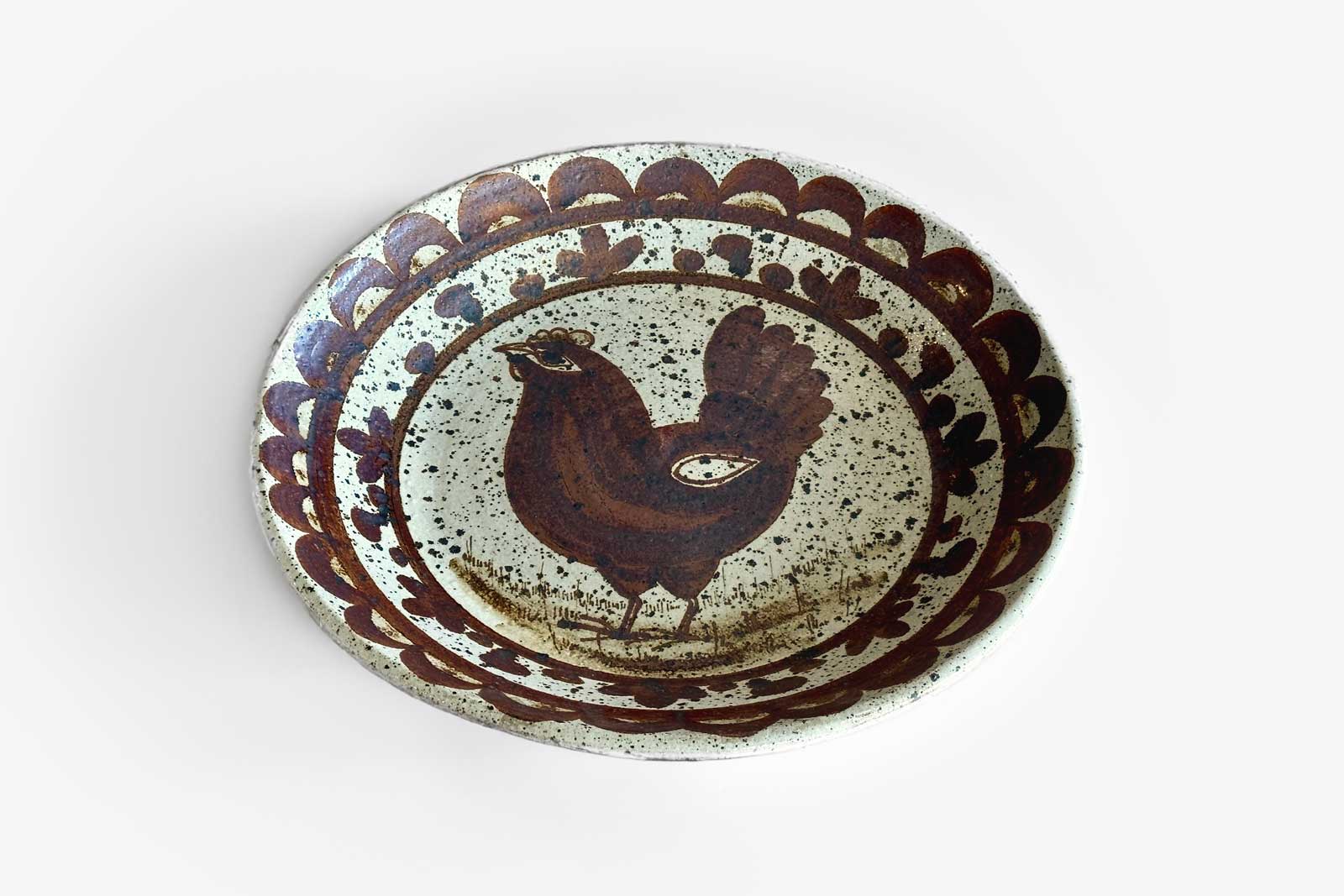
Nanna Ostgor
Chicken picture platter (production year unknown)
In Denmark, thick, heavy and hard pottery like this platter is called “STEN TOY”. English stoneware. In the 1980s, when Mr. Oda went to Denmark for research purposes, there were only one or two vintage shops. He had it displayed at his home in Osaka.
I liked the generous painting.
I forgot the price, but I’m sure I had a hard time buying it. (laughs).I think I found this platter around 1984-1987. At that time, I used to go to Denmark once or twice a year. Every time I travel, I used to stay at a cheap Inn with no bath or toilet in the room (there were two toilets and showers on the first floor), while eating breakfast, made sandwiches for lunch, hid them in my bag, and left. I wanted to save as much as possible and take home as many books as possible. Meanwhile, I found this picture plate at a vintage shop. I liked the pattern and the name of the artist was written on it, so I bought it without hesitation.
I think that the reason why there were almost no vintage shops at that time was that the people did not understand the value of their country’s past designs and manufacturing, and did not look back. From 1945 to 1965, Scandinavian design flourished, especially in the 1950s and 1960s. It was after this boom had passed that I started going. In a way, I went there at the right time, so I was able to collect all this. As I repeat, the Oda collection was created by encounters with the times.
At the International Furniture Design Fair Asahikawa in 1990,
We held the Finn Juhl Memorial exhibition.Later I gave this latter to someone. It was Mr. Manabu Tada, an architect and chairman of the executive committee for the Finn Juhl Memorial exhibition, which was held for the first time in Japan in 1990. Starting in Osaka, the exhibition traveled to Kyoto, Nagoya, Tokyo, and Asahikawa. The executive committee consists of 17 people, and the core members are Mr. Tetsuo Iku of the Sekisui House Design Department (later vice president), Ms. Eiko Senoo, a member of “Chairs”, and Denmark, who trained under Sukiya carpenter master carpenter Satoji Nakamura. People, Mr. Soren Matz, etc., joined by one person from each traveling city. Mr. Minoru Nagahara, the founder of Conde House, participated from Asahikawa. They made their own mahogany frames for posters. In Japan, where few people know the name of Finn Juhl, the exhibition was realized in five locations nationwide, so you can see how strong the passion of the core members was.
For the necessary money, donations of 10,000 yen per unit were solicited in Japan and Denmark. Mr. Mats was in charge of the English translation of the proposal.
Donations came in one after another from the Danish Embassy, the Danish Royal Family, the National Bankers Association, and others. Some people donated in units of 1 million yen, and the total amount exceeded 10 million yen. It was a time when there were patrons of culture. We also made a fine pictorial record and sold it for 1,000 yen per copy, but this pictorial record has recently been auctioned and seems to be worth 80,000 to 100,000 yen. The executive committee started at 6:00 every night and exchanged opinions on the content, display method, and division of roles, and continued until midnight each time.Mr. Nagahara said, “This is the first time I’ve ever met an executive committee with such a high level of enthusiasm. Everyone was carried away by the virus of Finn Juhl’s charm (laugh)
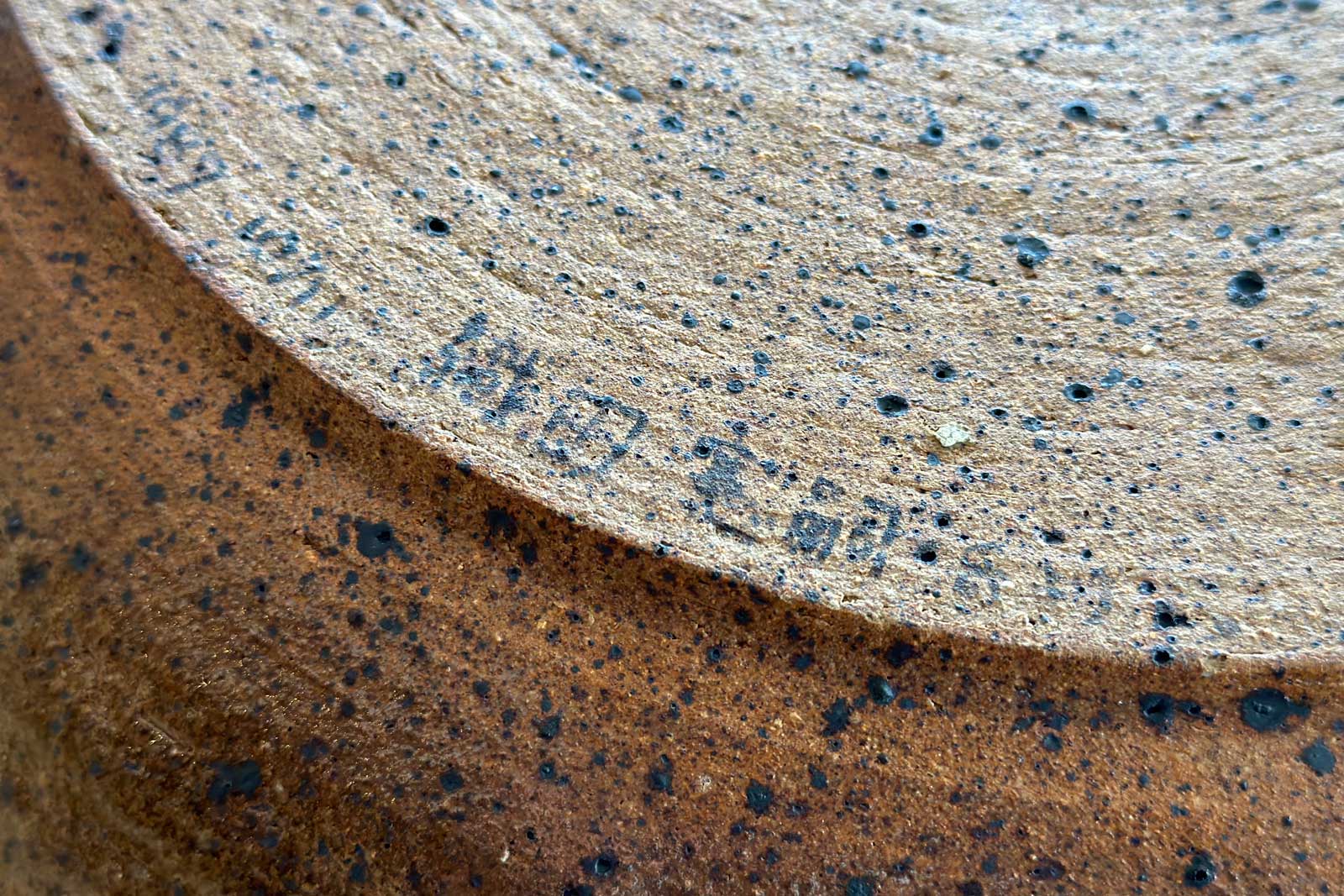
I would like to thank the committee chairman
for his great cooperation in the memorial exhibition.The exhibition ended successfully. With the remaining money, we held a consolation party at “Wakuden” in Kyoto, traveled to Yufuin in Oita with Hannah Wilhelm Hansen, Mrs. Finn Juhl, and the executive committee was dissolved. At that time, I was wondering if there was a way to express my gratitude to Mr. Manabu Tada, who, while serving as the chairman of the committee, spared no effort as an architect in setting up each venue. Mr. Tada had a strong feeling for Finn Juhl, and even though he said, “I can’t do my main job,” he took on the most troublesome work. And I decided to present my favorite platter as a present. Put my signature on the back of the plate, next to the artist’s signature.
This memorial exhibition was an epoch-making exhibition that introduced the works of Finn Juhl for the first time in Japan. Until then, it only appeared in a magazine called Kogei News around 1960. I am proud that this exhibition triggered his name and works spread in Japan. At the same time, I think that the Japanese gradually came to understand that a researcher is different from a collector who only collects things.
Approximately 30 years later,
I met this platter again in Kyoto.In 2019, I was asked by a person who was renovating Nintendo’s Kyoto headquarters building to open a hotel, “I want you to introduce the manufacturer of Asahikawa furniture,” and I showed him around Asahikawa. Three years later, he contacted me and said that he would like to invite me because the hotel was completed. I went out with my wife. When I arrived at the hotel, I was very surprised when I was shown to a room called a luxury suite for 350,000 yen per night (laughs). The room was furnished with Conde House furniture.
The next day, I went to the vintage shop “B Generated”, which I had stopped by when I came to Kyoto for nearly 30 years. When I was looking at it, thinking that there were still good things, my wife said, “There’s an interesting plate over here.” Quietly placed in the corner of the store, it’s a nice touch. Mr. Iwai, the owner, is a familiar face and said with a grin, “That plate has Mr. Oda’s signature on the back.” Then my wife and I finally remembered, “That plate that was displayed in the living room!” I immediately said “buy”. Mr. Iwai didn’t say anything about how the things I gave Mr. Tada came to be, and I didn’t ask him either. More than anything else, I was moved by the fact that things that had once left my hands returned to me again over time. It’s strictly forbidden to buy things in front of my wife (laughs), but this time I broke it. However, it is a secret that this plate was sent along with other secret purchases.
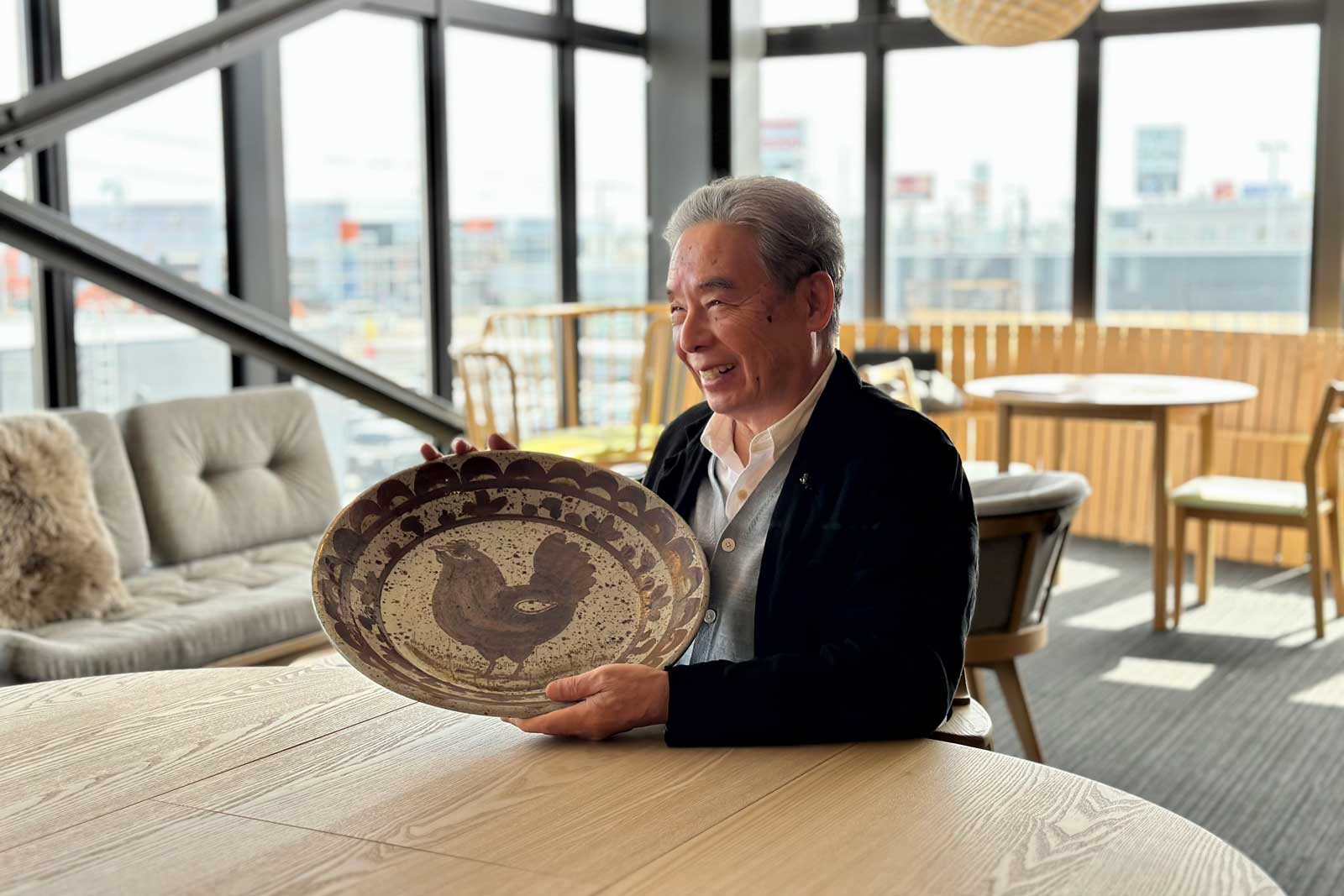
I have been living with the awareness of
why I was born.Recently, my wife has finally started saying, “I’m glad you worked so hard to come here.” People often ask me how I managed to pay for the purchase, but even I don’t know (laughs). I just kept working hard, working, working, working. Even if other people see it as a pastime, if you do it steadily, one day you will cross the line and become a culture. A little while ago, a friend of mine who was my partner when I opened my own office, Gabunsha, came to visit me. At that time, I was very happy when I was told, “Mr. Oda, you haven’t changed at all. It is natural that there is no blur. Now that I’ve entered the path of research.
“Ever since I was young, I was aware of what I was born for.” I don’t have the talent to continue on the path of creating things, such as illustrations and designs. Trying to set the goal of life on the side of leaving rather than on the side of creating. In fact, after I moved to Asahikawa, Mr. Nagahara from Conde House asked me to design a chair. I refused, saying that I didn’t want to throw away all that I had built up. Leaving masterpieces and making things by yourself are on a different dimension.
I cherish the words of an ancient Amazon Indio, “Those who try to leave things behind are those who lack confidence in their way of life.” I have no confidence in my way of life. However, there are beautiful things that should be preserved for future generations. I’m just doing it because someone has to do it. God is watching and lending me a hand from time to time. The platter that I was led to meet again this time is now placed on the table in front of the sofa in the living room and I am lovingly looking at it. No, I didn’t place anything on it. If I place something on it, I can’t see the beautiful picture. (laughs).
April 12th, 2023 Asahikawa Design Center 2F Lounge
Interviewer: Kano Nishikawa
[ After the interview ]
The interview was held at the newly renovated “Asahikawa Design Center” before the meeting of the Oda Collection Cooperation Committee. In the center is Mr. Tetsuya Fujita, chairman. This is a commemorative photo that I jumped into thinking, “It’s not easy to take a picture with Oda-sensei.” Mr. Oda brought the picture plate with hard work. I put it directly on the table, but as you can see in the photo in the article, there is a pad attached to the back of the plate so it’s okay. That’s Mr. Oda. Even so, this plate must have been waiting for Mr. Oda from Hokkaido to pick it up for a long long time. The plate looked as happy as Mr. Oda.
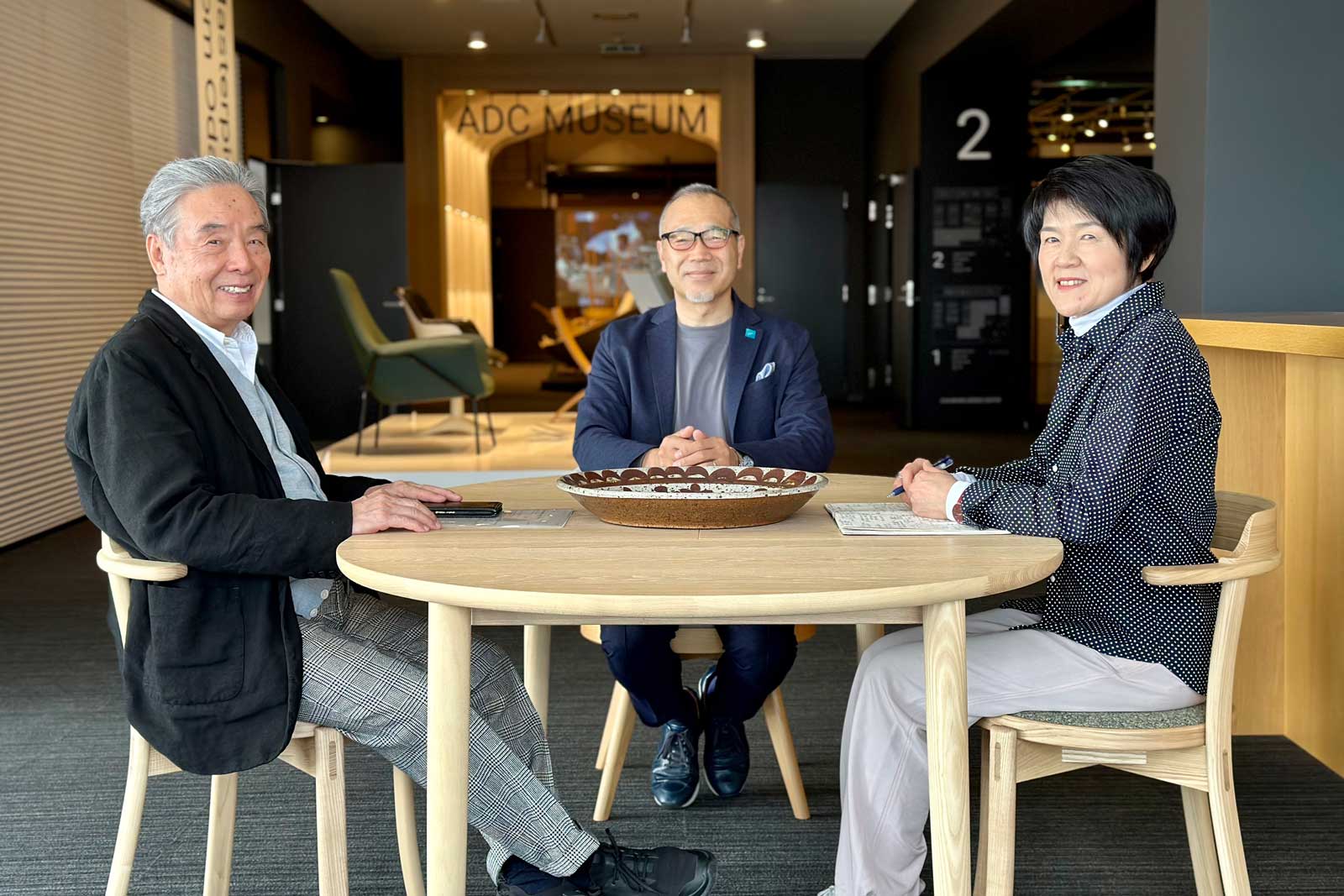
Copywriter Kano Nishikawa
After working at a design office in Tokyo and Sapporo, I started working as a freelancer in Asahikawa in 2001. Until now, I have been involved in the production of advertisements for local companies and organizations, including Asahikawa Furniture. I have known Mr. Oda for about 30 years through my work. -
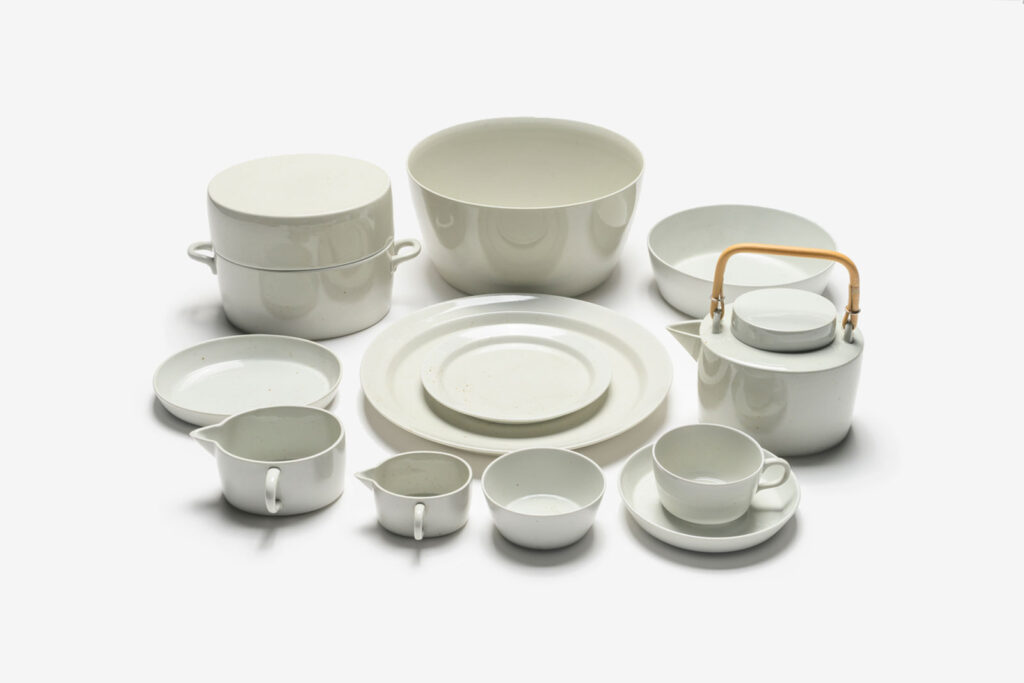
Episode 4: 200,000 yen just for the pot. One by one, it took 20 years collecting almost all items.
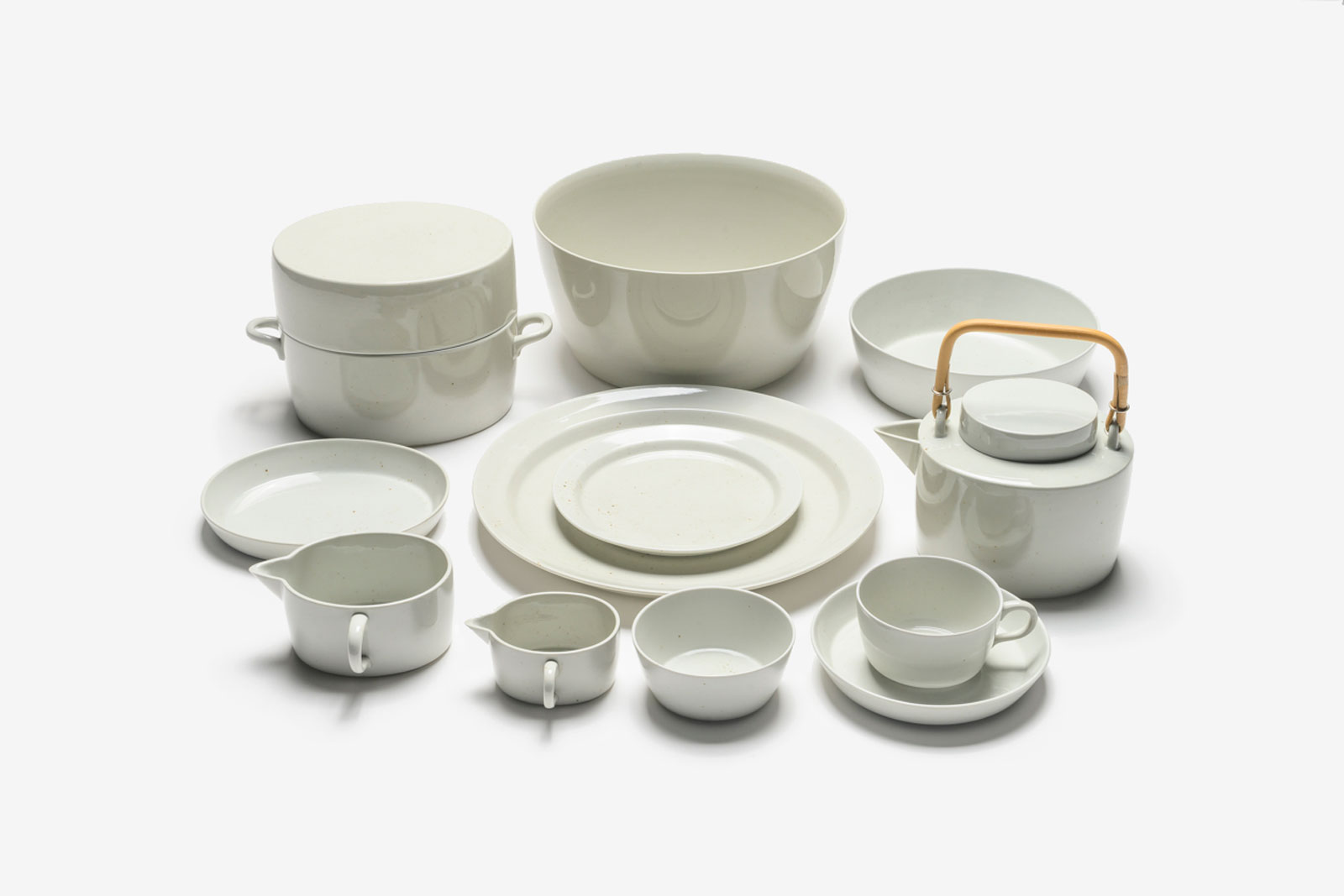
Gertrud Vasegaard
Capella (1975)
“Capella” is a newer serios among Vasegaard’s work. Older ones include “Tea Set (1956)”, “Gemma (1962)”, and “Gemini (1962)”, among which Mr. Oda says he likes Capella the best. Since it was only made in small quantities by Royal Copenhagen, it was difficult to find it on the market, and Mr. Oda had to spend a lot of time and money to collect them.
The first thing I found was the Pot.
It was 200,000 yen at “Lystig” in Kita-Aoyama.“If this series come in, be sure to let me know.” I don’t know how many years I had waited since I sent a photo from the 200-year history of Royal Copenhagen to the antique shop “LYSTIG” in Kita-Aoyama and asked them to contact me when it came in.
One day, I got a call saying “a teapot had been found” and this was the first item in my collection of Capellas. The tableware series “Capella” designed by Gertrud Vasegaard in 1975 was influenced by Japan, and while it has a modern Scandinavian design, the shape of the handle of the pot and the use of rattan etc. You can feel the harmony in the interior.Plain white vessels are not decorative, so the only way to make them stand out is the shape. If you look closely, this teapot has a slightly oval shape and is not flashy at all, but its skin is white with a slight gray tinge, almost like white porcelain, and is indescribably beautiful. Speaking of white, the white of “Domino” is also beautiful. A lustrous, deep ivory white that is likened to the smooth skin of a woman. There are many words for white in Japan, but the Alaskan Inuit, who live in snow and ice, have 150 expressions, such as “glacier white”, which is an image of a glacier.

The reason why there are few “Capella”
Because “modern” is considered as a risk.Even if designer thinks this design is good, it often happens that it does not go on sale if it doesn’t follow the direction of the manufacturer, or even if it does, it is produced in small quantities. Royal Copenhagen, which manufactures “Capella”, has the best selling “Blue Fluted” by Arnold Krog, who laid the foundation for the company, and like many famous European kilns, they tend to avoid modern ones.
Meissen is almost non-modern. Therefore, the “Capella” was also short-lived and expensive because it did not hit the market. For manufacturers, it is precisely because there is a series that earns money that they can go on adventures, but that’s why modern is “dangerous”. This is probably because Europe has a deep-rooted culture of respecting old things. In England, even older cars are taxed less.
I had only seen that “Capella” in print for a long time. The first time I saw the real thing was at the Design Museum in Copenhagen. This was the only time I’ve seen a pot and creamer, a cup and saucer, and a casserole. After I got the pot, a copywriter friend who has a hobby of researching daily necessities from Northern Europe told me, 2That store in Denmark sells casseroles and plates!” I did’t have credit cards, so I asked my daughter to buy it for me. In this way, I gradually purchased one item at a time, and it took 20 years to complete almost all items.
The display of daily necessities should be in a group.
That’s why I collected the series.Daily necessities are designed by a single designer in various variations according to the purpose, and it is worth seeing when it comes together as a whole. I want many people to see the diverse designs at the exhibition. The splendor of “daily necessities with artistry” cannot be conveyed by exhibitions like works of art.
When choosing what to exhibit, I always draw a freehand map of the venue. Based on the exhibition list selected according to the theme, I check the dimensions of each item, which chair, which table goes where, lighting here, daily necessities here, and so on and I adjust all of them and decide.

Even if it’s uncomfortable to use, it’s ok.
You can say love is blind (laugh).I use the furniture and lighting from the collection at home, but I can’t quite use the tableware. Because if you break it, you will never get it again. That’s why I end up buying multiple things that I want to use (laugh). Easy to use? It doesn’t matter. I like it even if it’s uncomfortable to use.
Of course, when I lead them to an exhibition, I ask them to handle with special care. Kay Bojesen’s coffee service set (P.213) in the catalog of this “Nordic Design Exhibition”. I have bitter memories of this. When I came back from one exhibition, the mouth of the pot was missing. I couldn’t help it, so I searched for a broken set at an auction in Denmark and bought it again. Vasegaard’s tea set (P.250) also had a broken handle when I unpacked it after I finished renting it. This is the saddest thing about tableware, and it’s hard to prevent that from happening. We are devising such as making a special box so that it will never break. Come to think of it, the dozens of packing materials that Nippon Express brought in this time, sandwiched between cushions, were good. Both the tools and the skill are truly professional work. The cotton futon wrapped in Japanese paper was also convenient, so I asked for it and left it for the next time.
Actually, I started collecting daily necessities
before I started collecting chairs.People tend to think that my chair collection has expanded to include everyday items, but the fact is, it’s opposite. Since I graduated from University and joined Takashimaya, I have loved tableware and bought it often. After all, there are many Scandinavian products, and the Dansk pot that I exhibited this time is one of them. The bread plate for breakfast that I still use at home is from Norway’s “Porsgrund”. I’ve been using it for over 50 years, so the pattern on the plate is worn out, but I like it because it’s just the right size. I’ve also been using the movable Italian lighting under the atrium of my house for 50 years while fixing it myself. When I was newlyweds, I found a Danske fondue set in town. I don’t hesitate to buy a good one, but when I saw it, it was 50,000 yen to 60,000 yen with the warmer set. I remember spending all the money I had at that time, and I was sweating hard to see if I could barely have enough money, but I was able to buy it. After that I kept buying it because it was “beautiful” and the number gradually increased. And since I decided to pursue the path of a researcher, my collection continues to grow due to my sense of mission.
March 6th, 2023 Centpure (Higashikawa)
Interviewer: Kano Nishikawa
[ After the interview ]
This photo was taken when I interviewed Mr. Oda for the first time. The date was the summer of 1991 and the location was CondeHouse. It seems that Mr. Oda is holding the water droplets on the glass with a handkerchief. That’s so him! (laugh). It’s been over 30 years since then. He teaches me the importance of living a mindful life every day. Even now, there are times when I am taken back by what he said when he gave me a foliage plant. “Plants need a little bit of love. Don’t be without it.”
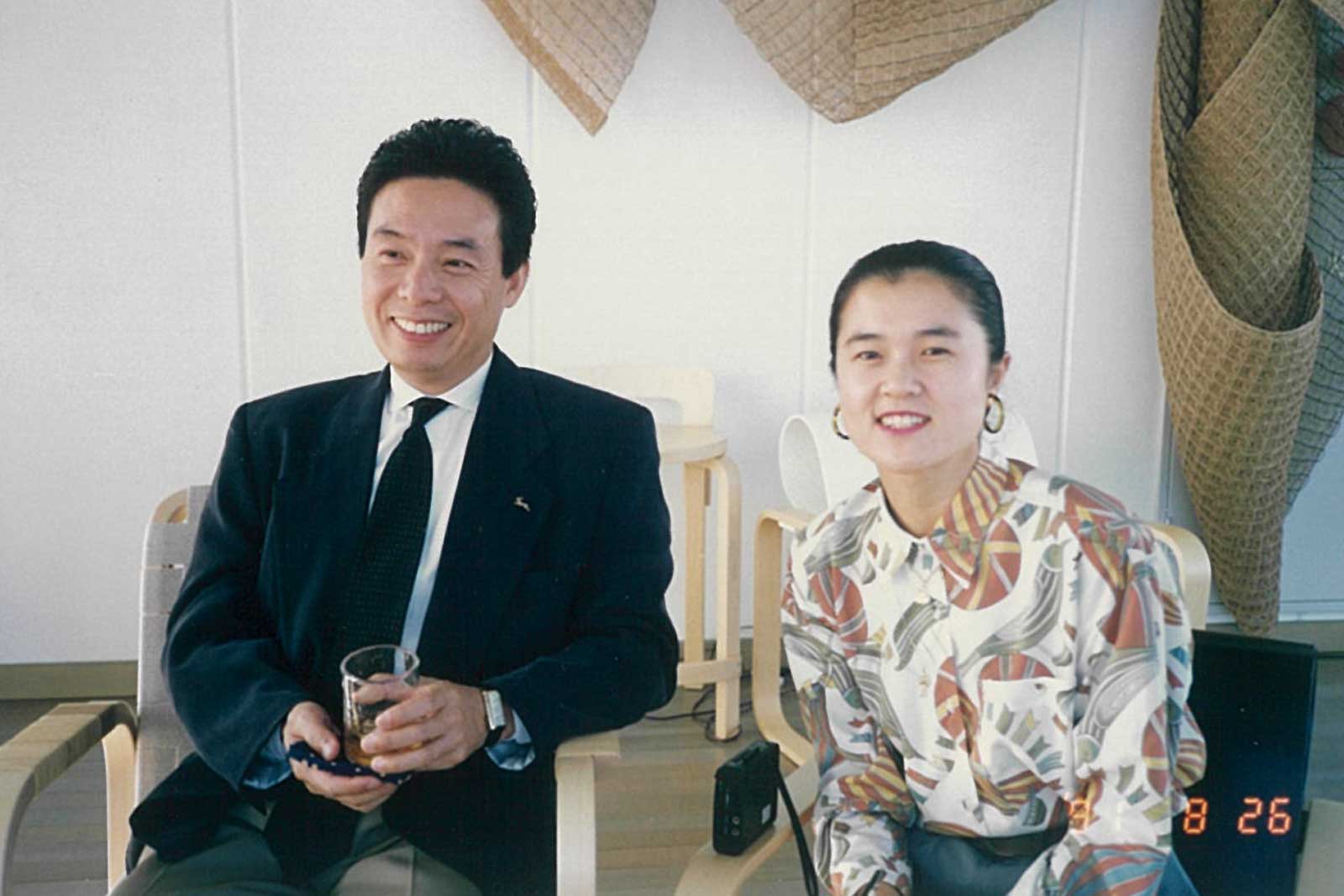
Copywriter Kano Nishikawa
After working at a design office in Tokyo and Sapporo, I started working as a freelancer in Asahikawa in 2001. Until now, I have been involved in the production of advertisements for local companies and organizations, including Asahikawa Furniture. I have known Mr. Oda for about 30 years through my work. -
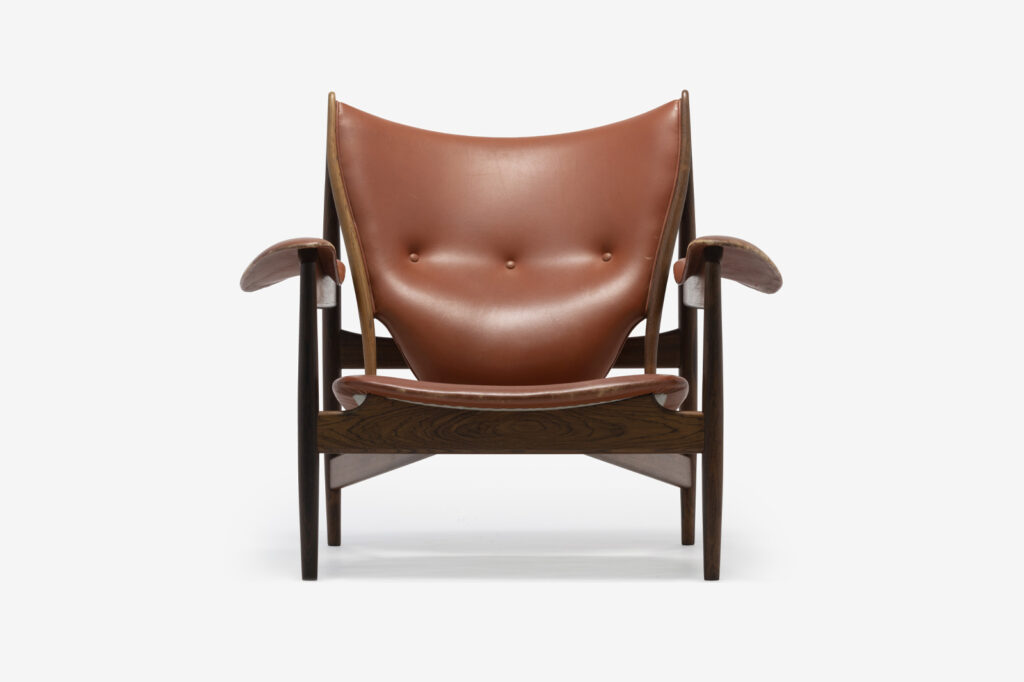
Episode 3: At an auction in Denmark, the agent forgot the instruction the buyer to “compete up to 10 times the expected bid price” and it heated up.

Finn Juhl
Chieftain Chair, 1949
A Finn Juhl masterpiece, this historic chair was designed for use by the fireplace in your living room. In the spring of 1949, he started drawing around 10 in the morning and by 2 or 3 in the middle of the night, the form and details were completed as he had envisioned. According to Mr. Oda, “There is no other chair that is as majestic, dignified, intelligent, and classy.” Oda Collection has 4 chairs from different manufacturers.
Hired a Japanese expatriate in Denmark
to collect information and chairs.For about five years from 1984, I paid a Japanese man living in Denmark to gather various information about chairs. He was a guide for Japanese tourists and had some knowledge of furniture. His job was to cut out interior and furniture news from local newspapers such as the POLITIKEN newspaper, translate them, and send them to the laboratory chairs. When I had something that I wanted to ask a designer, he visited and interviewed them for me. He also accompanied Wegner, Finn Juhl, Grete Jalk, and Bernt Petersen as an interpreter.
And the most important job was to participate in the auction. When I receive information about the auction, I asked him to go to the venue on the first day of the preview, took pictures of the exhibited works, and have the prints sent by air express delivery. I selected a work, looked at the estimate (estimated bid price), write “how much”, and send it back by air express delivery. We didn’t have the internet like we do now, so everything took time and effort. And on the day of the auction, he participates in his place.
A Chieftain Chair was put up
for one auction!!About three or four years after I joined Takashimaya, I was shocked to see the “Chieftain Chair” in a magazine. “What a fascinating chair.” I thought I would definitely get one someday. 78 of these chairs were manufactured in the Niels Vodder, 10 in the Ivan Schlechter (engraved), reproduced from the 1980s in the studio of Søren Horn’s apprentice Niels Roth Andersen, now manufactured and sold by One Collection, which is run by Hansen & Sorensen.
The first Niels Vodder workshop is housed in Danish embassies and museums around the world and is rarely seen on the market but one day in 1986, I found out that it would go up for auction in Denmark. After waiting for this opportunity for years, I told him to “compete up to 10 times the expected winning bid.” There were many competitors at the venue, and the prices went up steadily. Competitors were dropping out. The last one was a one-on-one fight with the remaining opponent and him. Perhaps he was overwhelmed by the atmosphere, he got so excited that he forgot the instructions and repeated bids until he finally won the bid. The winning bid was far beyond my budget.
In “expensive purchase”, it was worth
not to regret it.When I heard about the situation, I was in a shock, thinking that it was a very expensive purchase but at the same time, I reconsidered, “I won the bid, so let’s be happy” and I immediately made a loan at Mitsui Bank and sent money. There is a sequel to this story. In 1987, the year after the auction, I met Mr. Finn Juhl, and he said, “The Chieftain Chair you’ve been looking for for a long time, it came up at auction last year and fetched a great price.” He didn’t seem to know that I had won the auction. “I received an inquiry from the Vitra Design Museum, and since they competed at the auction but didn’t win, they asked me if I could sell it.” Surprisingly, the opponent of the one-on-one combat at that time was Vitra. “After all, Vitra found a teak wood one in New York and bought it for about the same price as the winning bid.”
There was one more thing that I learned later. Of the 78 chairs made by the Niels Vodder, only 5 were made of Brazilian rosewood, the rest being teak. The five chairs have become increasingly rare and acquaintances say that when they were put up for auction at Phillips in London 13 or 14 years ago, they were priced at 80 million yen. The one I won the bid for was exactly that rosewood specification. Come to think of it, at the auction in Paris, I heard that the prototype of the “Grasshopper Chair” that Mr. Finn Juhl once bought (only two of them were prototyped) was put up for auction through a person and was sold for about 400 million yen and the world is like that. After all, my collection was made possible because it was that time when no one paid attention to it. Even so, the loan from this successful bid was a large amount, and I had to work hard every day.
Countless things were rescued
from the closed workshop.I asked him one more thing as an expatriate. At that time, I asked him to go to the furniture workshops that were closing down one after another and asked to gather information to see if there were any remaining products or parts that could serve as important materials. When Christensen & Larsen closed their workshop, he took pictures of the interior and sent them to us. I repeat, it’s not a cell phone photo. Printed film photos were put in an envelope and delivered by airmail (laugh). In the photo, I saw a part that looked like a chair frame hanging in one corner of the room. I searched the literature and found that it was a prototype of the Easy Chair released in 1949 by Ib Kofod-Larsen. I told him to assemble it and purchased the finished product. I still use it at home now but it is the only chair in existence in the world.
A.J. Iversen is one of the most prestigious studios that uses Brazilian rosewood as its main material. He manufactured armchairs and high-end furniture for 800,000 yen and sold them to European aristocrats. When I heard that the company had decided to go out of business and had a goodbye sale, I immediately told him to hold down for each type. I received a report from him that he had taken 26 of them, and I took out a loan at Mitsui Bank. There were many materials that have been rescued in this way.
A dying Chieftain
which recently arrived.It was this summer. A friend of mine, Mr. K, who owns a foreign book store, contacted me and said, “There is a person who wants Mr. Oda to buy his Chieftain Chair.” I immediately asked, “Is the seat covered with leather?” If it is covered with leather, it is a rare item with only 10 chairs in the world. Reply was, “It is covered with leather.” It is the phantom Chieftain Chair made of wood by PP Møbler, Ejnar Pedersen and upholstered in leather by upholsterer Ivan Schlechter. “But…just…” Mr. K hesitated. I heard that the owner, a Dutch sculptor, sold it to a lumber merchant for money, and that it was in extremely poor condition. I hesitated for a moment, but it was clear that it is worth keeping as a document. I decided to purchase it because I thought it would be possible to restore it with Asahikawa Furniture’s skills. The chair that was sent to me was torn and the tip of the characteristic hind leg was missing, and it was in a more tragic state than I had imagined. Currently, they are doing restoration work at a manufacturer in Asahikawa.
November 8th, 2022 Centpure (Higashikawa)
Interviewer: Kano Nishikawa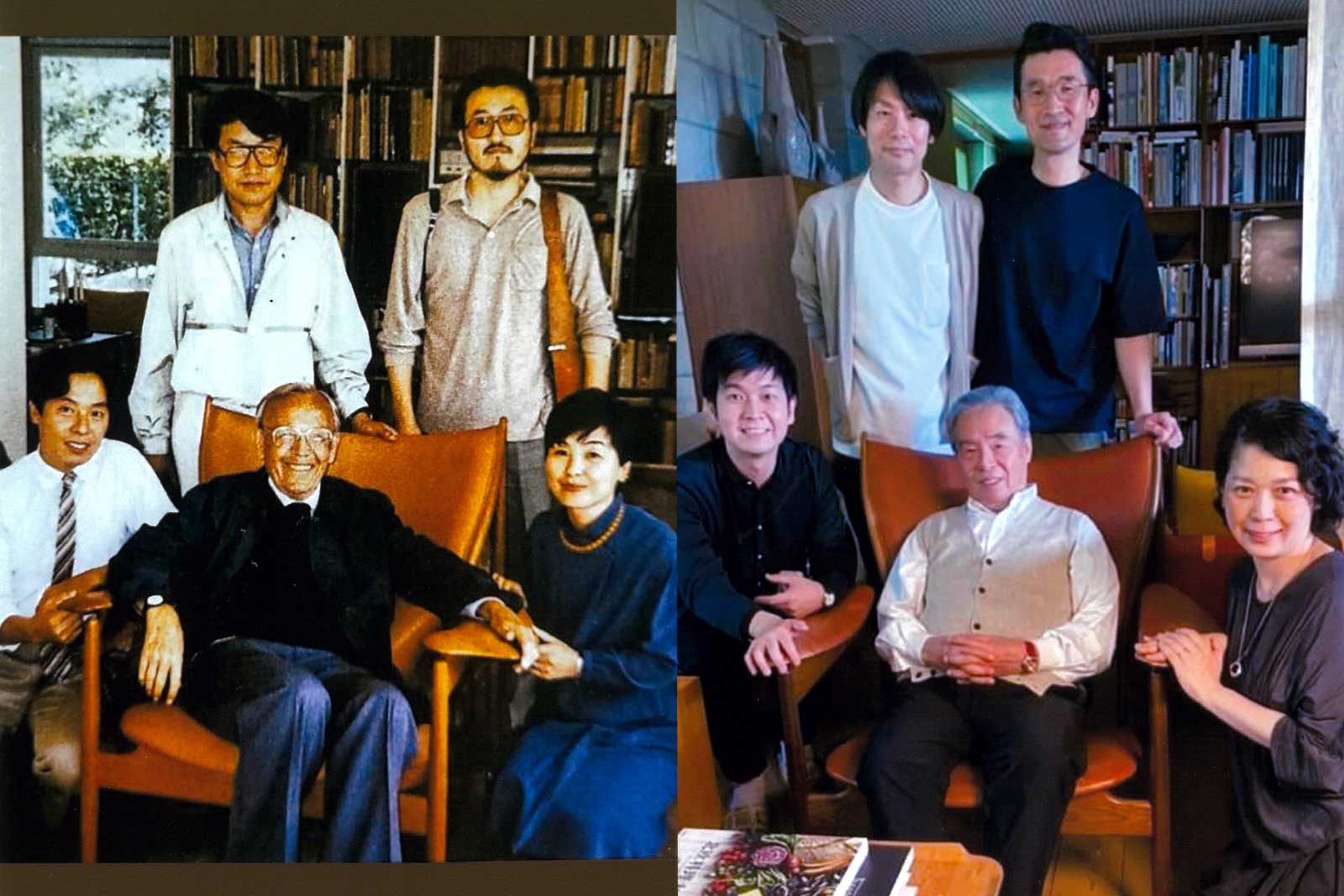
The photo on the left is from a visit to Mr. Finn Juhl in 1984.The photo on the right is taken by a visitor at my house. I’m surprised by the composition that looks too much like it even though he didn’t imitate it.
[ After the interview ]
This interview was conducted at Mr. Oda’s desk because the lounge room was full of students. He maintained a style of keeping a distance from IT, to the extent that he has recently been forced to “hold” his smartphone (according to himself), so he does not have a computer on his desk. Documents are handwritten, manuscripts are handwritten. Carefully written with a thin mechanical pencil. I also handwrite the interview with a fixed notebook and a pen, and I don’t record it on my iPhone. In this way, an analog interview scene that has not been seen much in recent years. (laugh)

Copywriter Kano Nishikawa
After working at a design office in Tokyo and Sapporo, I started working as a freelancer in Asahikawa in 2001. Until now, I have been involved in the production of advertisements for local companies and organizations, including Asahikawa Furniture. I have known Mr. Oda for about 30 years through my work. -
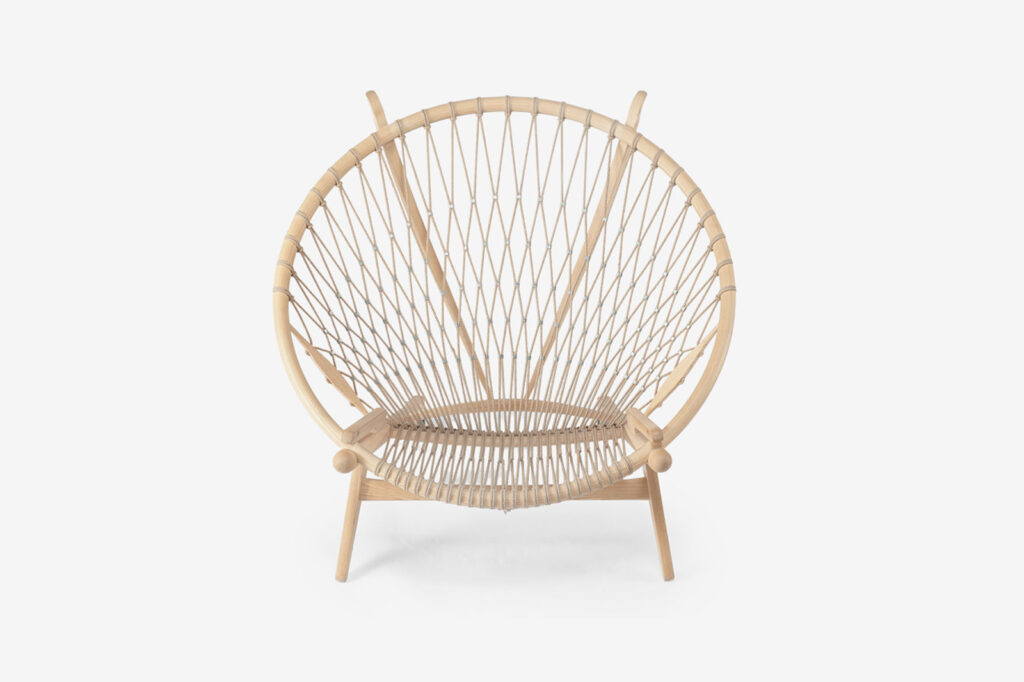
Episode 2: Since I visited Mr. Wegner’s atelier in 1984, we had been in contact for 20 years. One day, out of nowhere, this chair was sent to me.

Hans J. Wegner
Hoop Chair, 1986
A good example of how advances in science and technology make new designs possible. PP Møbler’s second generation Søren Pedersen devised a machine to make the round frame, which was originally designed with metal pipes, by molding wood, and realized the current structure. It features a radial rope work, and the rope used for the yacht is stopped with small metal fittings. An idea for not making a knot considering the comfort on the back.
The letter says “For research”.
Mr. Wegner knew I didn’t have this chair.The Hoop Chair was sent to my apartment one day out of nowhere in Minoo, Osaka. It was in 1987, soon after it was commercialized in 1986. It had a letter inside from Mr. Wegner saying, “I will give this as a gift for research.” Mr. Wegner spares no effort in helping to promote research and design, and has donated all the exhibits of the Wegner Museum in his hometown of Tønder. When I received the Hoop Chair, I was reminded of how he recognized me as a researcher.
I first met Mr. Wegner three years earlier, in 1984, when I visited his atelier in Denmark. As I always talk about in lectures and interviews, in 1980 I established a private chair laboratory called “CHAIRS” launching. The group’s members, Ms. Kinuko Senoo of Kyoto City University of Arts, and Mr. Yoshio Hayashi, a photographer, decided to go to Denmark for research, and the first research trip was realized. The very first places we visited were Mr. Wegner and Mr. Finn Juhl. I forgot which place was first, but it was a very extravagant plan to visit these two in the morning and afternoon on the same day.
I had so many questions to ask,
I couldn’t sleep well the night before.At that time, requests for interviews were by letter. I expected that it would be difficult to have an interview, but I looked up in the dictionary with Ms. Senoo to write the letter, but Mr. Wegner immediately agreed to our request. It may be that we were able to convey his enthusiasm to visit for research purposes, not just for magazine coverage. On that day, we brought a “CHAIRS card”, which is part of our research activities, which is like a family register of chairs, and brought documents of about 700 Danish chairs. Mr. Wegner saw it and seemed to understand our intentions. His house was semi-basement on the mountain side, and the entire lower floor was his atelier, with a workshop, design room, and library, but he showed me everything except the bedroom. The family room on the upper floor was a room that was usually closed to visitors, and I think we were the first Japanese to go in there.
At this time, Mr. Hayashi, a photographer gave Mr. Wegner his four-direction photographs (4 times 5 size reversal film) of his work. He was very pleased and said, “I’ve never taken any pictures by myself before.” Later, as a thank you, we received 30 full-scale whiteprint drawing of chairs. Since this interview, I have been in contact with Mr. Wegner for more than 20 years, and have met in person eight times in total. I remember when I visited again the following year. That time, I took a file with a list of about 400 chairs out of about 500 by Wegner’s work that I drew by hand. There are blanks here and there. In Japan, I couldn’t figure it out no matter how hard I looked it up, so I showed it to Mr. Wegner and asked him, “I want you to fill in these parts.” Then he replied, “That’s your job. Do it yourself because it will be research.” When I think about it later, I imagine that this was also a word of encouragement to us.
Wherever we go,
“CHAIRS card” completely changed the attitude of people.The purpose of this trip to Denmark was to visit and collect information on author, manufacturers, and to visit trade fairs. However, even if you ask for an interview at a manufacturer or at a trade fair, they won’t let us and they said “Japanese people imitate everything.” Each time we present a box of “CHAIRS card”. As soon as they saw it, their attitude changed and they cooperated with the interview, and the same situation repeated the scene many times.
For example, Herning’s national trade fair. At the entrance, I was warned that “photos are not allowed”. I bought a baby chair for research at the venue, and then entered the Møbel-Gruppen, an exhibition of young furniture designers held at the same venue. The cold attitude was the same there, but when I took out the box and showed “CHAIRS card” to them and explained that we came from Japan to fill in the empty items, his expression suddenly softened and he was very helpful. Gorm Harkaer, who became friends there, later published a book as a researcher of Kaare Klint, the father of Danish design. I kept in touch with Eric Coe even after returning to Japan. He later became the principal of the National Danish Design School.
I can’t believe it now
witnessing the crisis situation in Denmark.The reason I chose Denmark as my first destination was not for positive reasons. I thought, “If I don’t go now, I won’t make it in time.” At this time, Denmark’s main industry, the furniture manufacturing industry, was in decline, and the craftsmen were aging and factories were closing down one after another. The causes were the depletion of resources, the lack of manpower and the decline in competitiveness due to negligence in human resource development, and the old-fashioned manufacturing that does not incorporate the trends of the times. And with the rise of Italian modernism, Scandinavia was no longer looked at. The end of the Scandinavian boom that swept the world from 1945 to the late 1960s. In such a case, valuable chairs and materials will inevitably be lost. I had to hurry, because the material of wood can become useless if left alone.
Prior to the Danish coverage, when I interviewed people who are very knowledgeable about Denmark, they said, “Even if you go to Northern Europe now, there’s nothing” and “What are you going to do with researching something covered in dust?”. However, when we actually went there, we found a lot of valuable things left behind, and in conclusion, this trip was extremely rewarding for us, who embarked on the path of researchers. On the contrary, it can be said that it was easy to obtain masterpiece chairs and materials because it was such a situation.
After that, I went to Denmark many times. Denmark’s largest bookstore, “Arnold Busck”, which I became a regular customer of, has a branch with a good selection of antique books and I borrowed a chair and spent an hour or two picking out books. Even with a vague degree of understanding while looing up a dictionary, I knew the importance of it. You could find a lot of things that you could never get in Japan. A pile of books was forming next to me (laugh). The exhibition catalog I bought there was on display at the exhibition “Finn Juhl and the Danish Chair” held at the Tokyo Metropolitan Art Museum from the summer of 2022. That’s how easy something so rare was available to get back then. There are about 250 back numbers of the interior magazine “Mobilia” on two and a half shelves, and the architectural magazine “Architecten” published in the 1800s is a combined annual book that has everything up to the 1930s. Among them, the “Denmark Design Museum” is posted in comparison with what it looked like when it was once a hospital. It’s really precious.
What I learned from the factory tour.
It is the discarded parts and the “…” of the master.When it comes to crisis situations, the two companies I signed up to visit were no exception. Johannes Hansen had only two skilled workers, and Carl Hansen had only two Y-chair paper cord weavers and only one assembler. At the factory of PP Møbler, the successor to Johannes Hansen, defective parts were thrown away. When I asked why, they said, “We can’t use it because it has knots,” and “It got wrinkles from super bending (molding).” As I got it as a document, one suitcase was full and I was stopped at the airport saying “over weight!”. I remember asking the other members to stuff it little by little into their suitcases and managed to come back. It’s still a pity that I didn’t get the parts for the “Valet Chair” that I found at that time (laugh).
I once visited PP Møbler with Mr. Wegner. The president, Aina Pedersen, was still doing well. I found a work by Poul Kjærholm there and asked Mr. Wegner what he thought. Mr. Wegner said, “He was an excellent designer.” When I asked him who he respected as a designer, he simply replied, “Charles Eames.” Then Aina poked me with his elbow. Then, in a low voice, he said, “Don’t ask too much about other designers.” Aina seemed nervous because I asked him anything without knowing it.
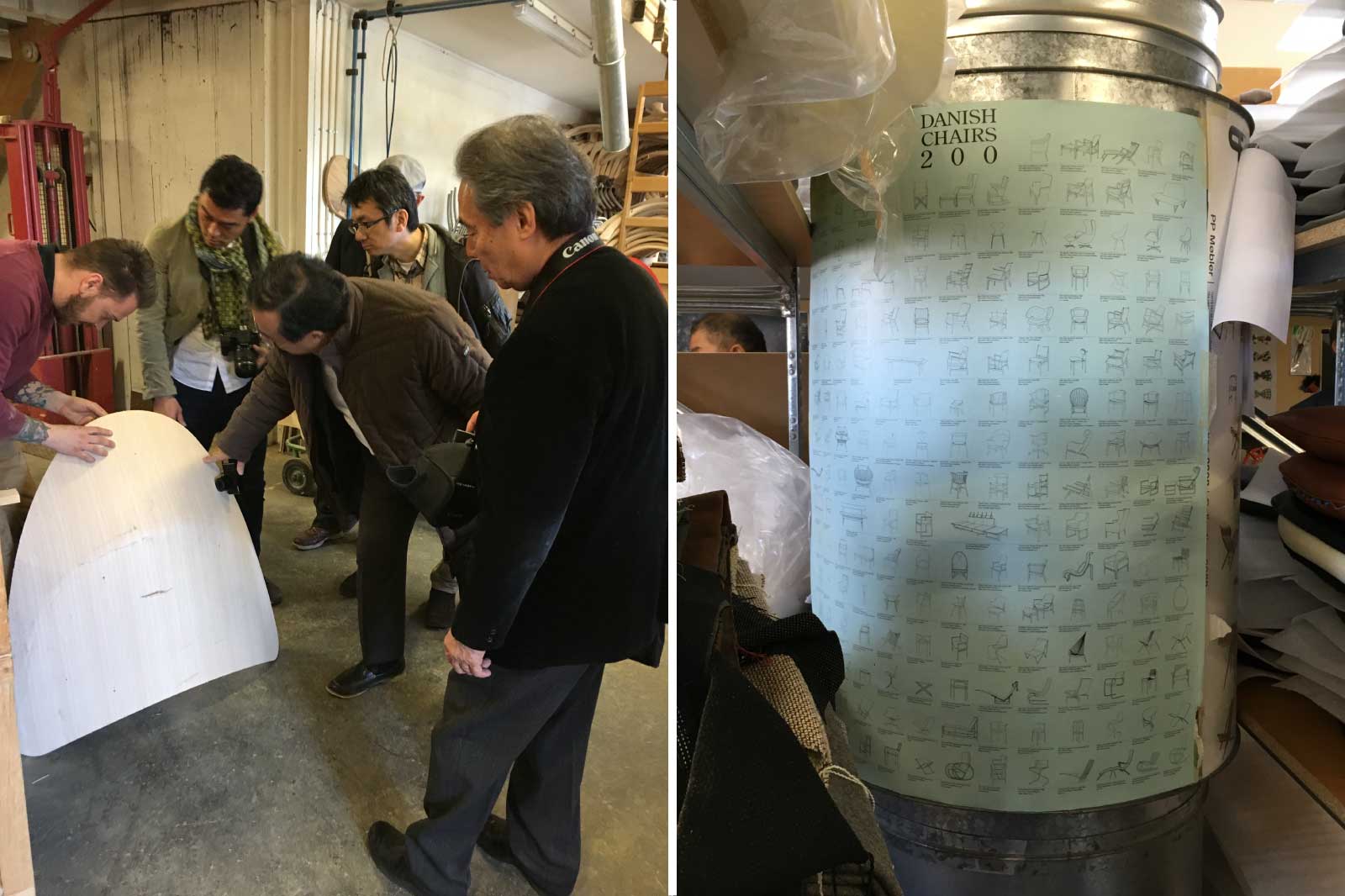
Left: In the spring of 2016, Mr. Oda visits PP Møbler on a training trip for the Association of Small Business Entrepreneurs. / Right: A poster with Mr. Oda’s illustration in the material room of PP Møbler. The reason for the discontinuation that he could not tell me,
I found out after I got home.At that time, something like this also happened. When I asked him what was wrong with a certain Mr. Wegner’s design chair that have been discontinued but Mr. Wegner would not answer. And Aina quietly said to me, “You shouldn’t ask.” When I went to PP Møbler again the following year, I asked if I could buy the discontinued product. When I told Aina about “some incident” in Japan as the reason I wanted to buy it, he said, “Is that what happened? Then, wait a minute.” He went to the back of the factory and 10 minutes later, he came back and said, “I found it!”. Then he said, “I will assemble it and send it for research.”
“The certain incident” was long before that in Japan. When I went to a gallery in Osaka, I found the “Stacking Chair PP-55” on display and wanted to buy it. Unfortunately, I was told, “If Mr. Oda wants it, it must be a valuable item, so I won’t sell it” (laugh). In the end, the chair that I couldn’t buy was the aforementioned discontinued product, and Aina, who heard about it, helped me. Later as promised, Aina sent me assembled chair. As I watched Mr. Yoshio Hayashi photograph the chair, I was startled. I know why it was discontinued. The “PP-55” is made of bent plywood for the “joinery” under the seat and it stretches so legs get distorted. However, this is just my guess, and I could never confirm it with Mr. Wegner nor Aina.
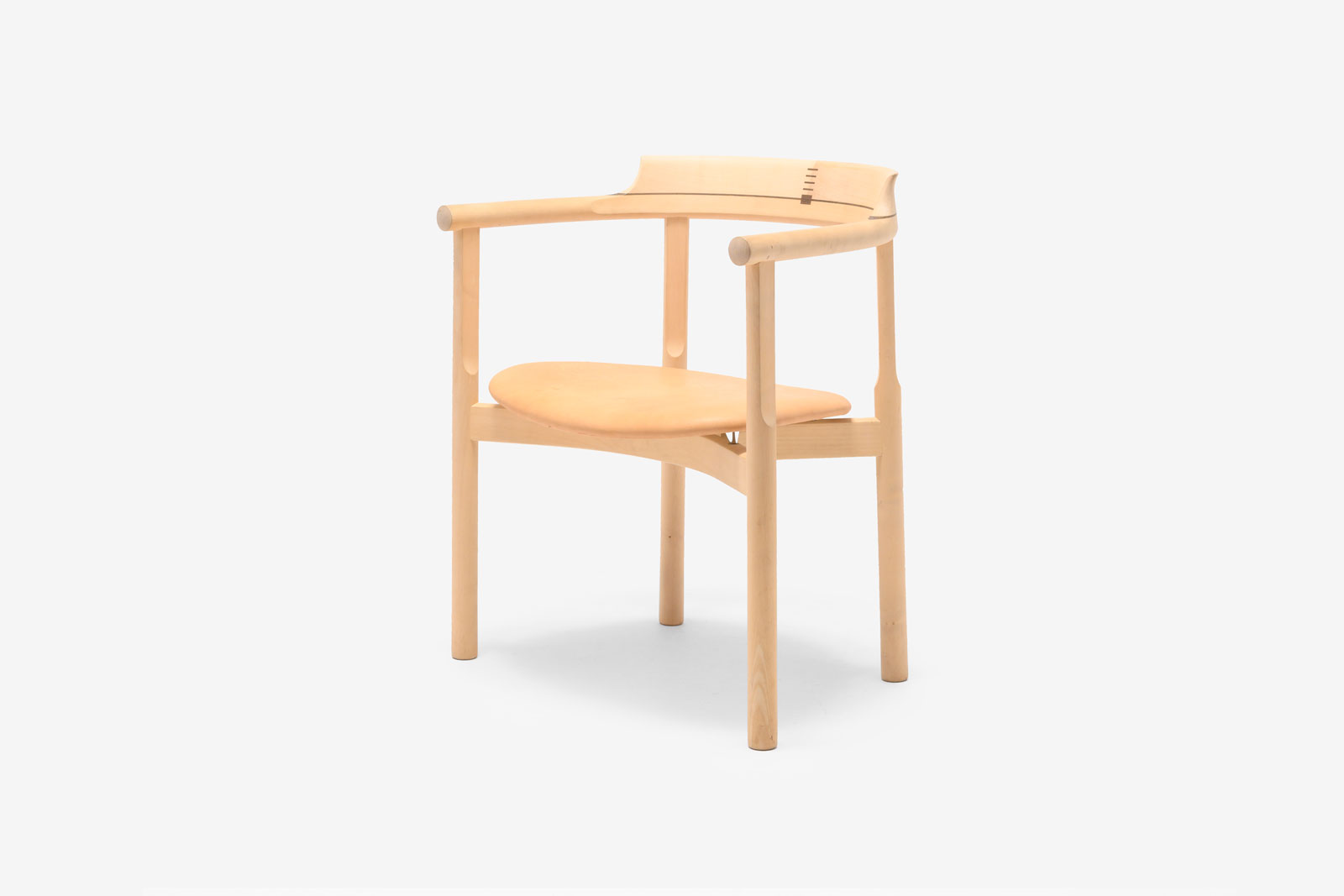
PP-55 September 27th, 2022 Centpure (Higashikawa)
Interviewer: Kano Nishikawa
[ After the interview ]
Some years ago, I traveled to Finland, Sweden, and Denmark with Mr. Oda for the overseas training of the Association of Small-and Medium-Size enterprises. At that time, I visited the museum shops and bookstores with Mr. Oda and the way he picks up books and buys all those books made me feel so pleasant. Mr. Oda who buys many thick books without any hesitation even thought he is traveling and carries a rucksack that hangs down heavily. But after listening to the story this time, I understood that it was a very normal behavior for him (laughs). (Nishikawa)
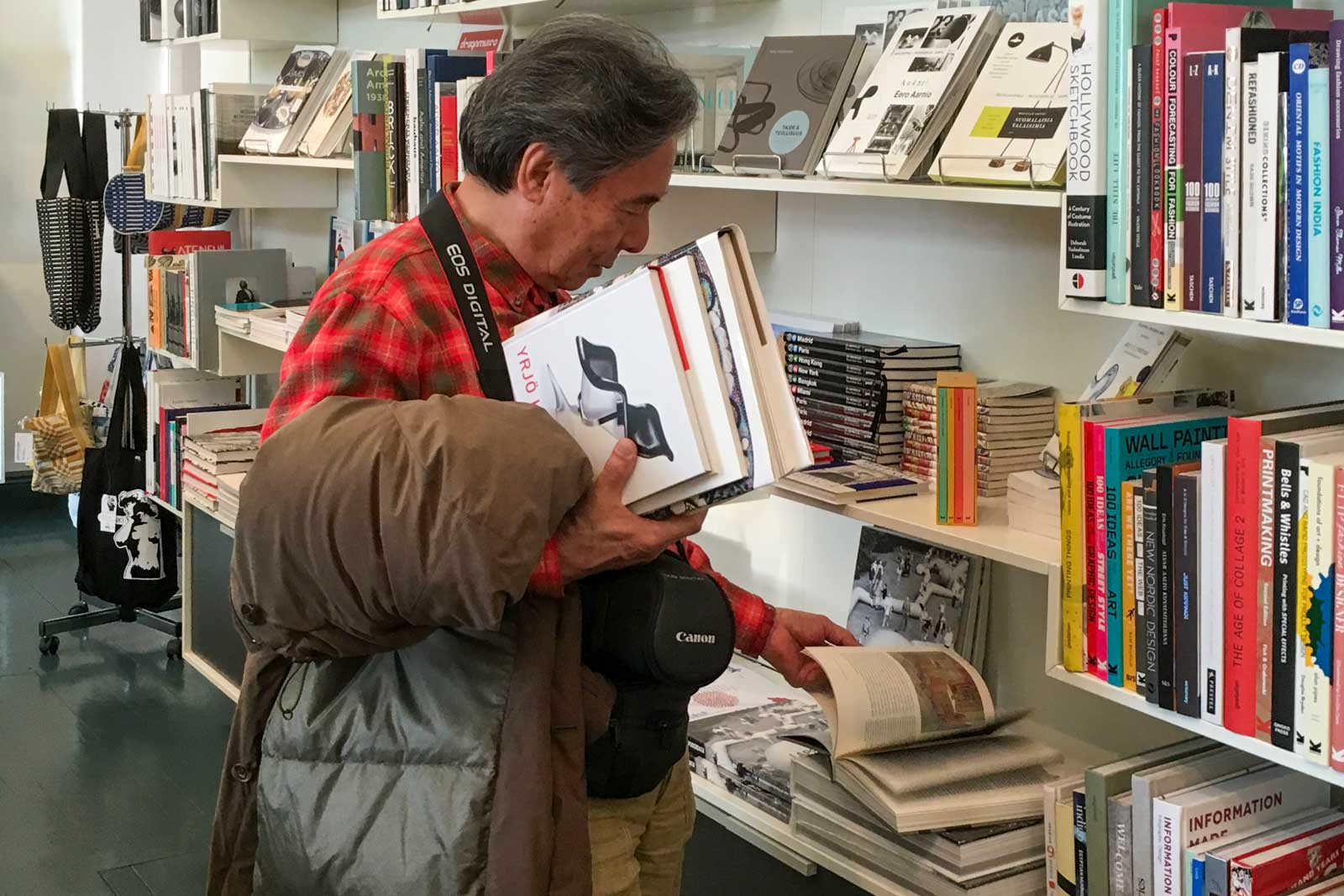
Mr. Oda who picks up more and more books. 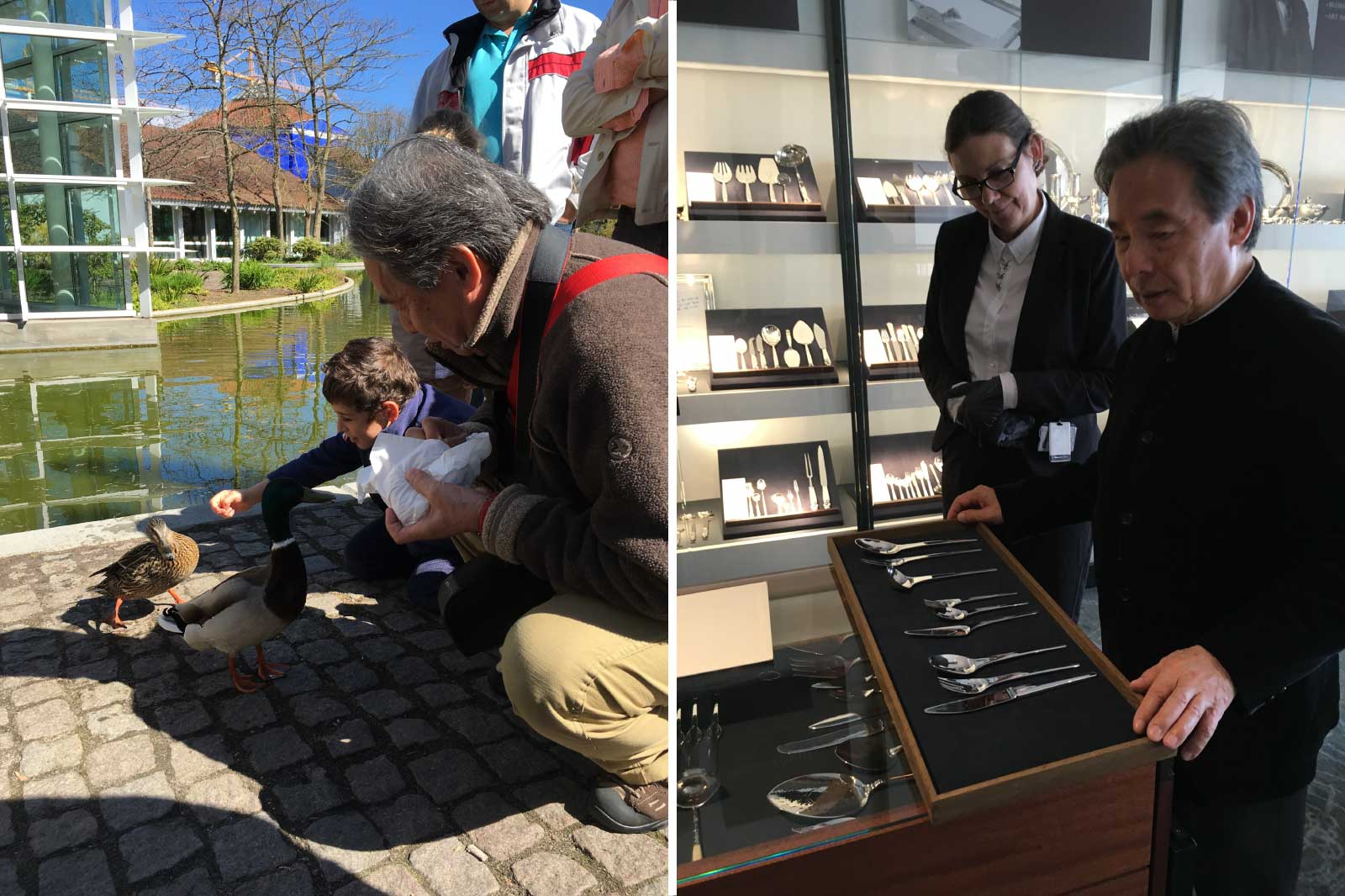
Left: In Odense, Denmark, no matter where you go, Mr. Oda who is kind to birds, the bread in your pocket to the ducks. / Right: Purchased sterling silver cutlery designed by Henning Koppel at the Georg Jensen flagship store in Copenhagen. Copywriter Kano Nishikawa
After working at a design office in Tokyo and Sapporo, I started working as a freelancer in Asahikawa in 2001. Until now, I have been involved in the production of advertisements for local companies and organizations, including Asahikawa Furniture. I have known Mr. Oda for about 30 years through my work. -
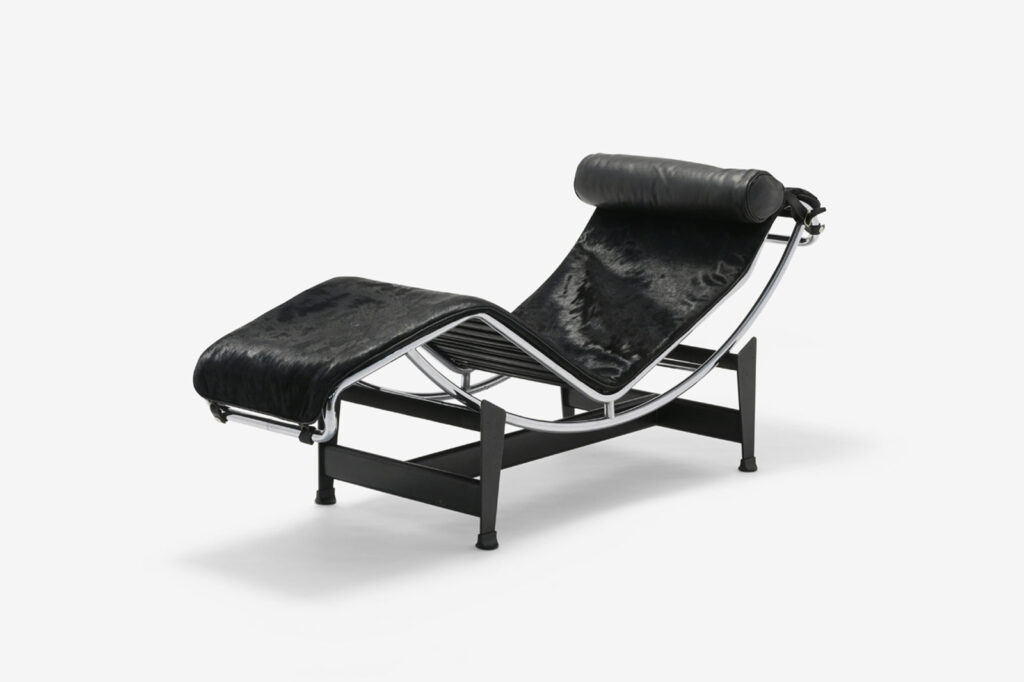
Episode 1: The very first chair in Oda Collection. This is where my “act of studying chairs under adversity” starts.
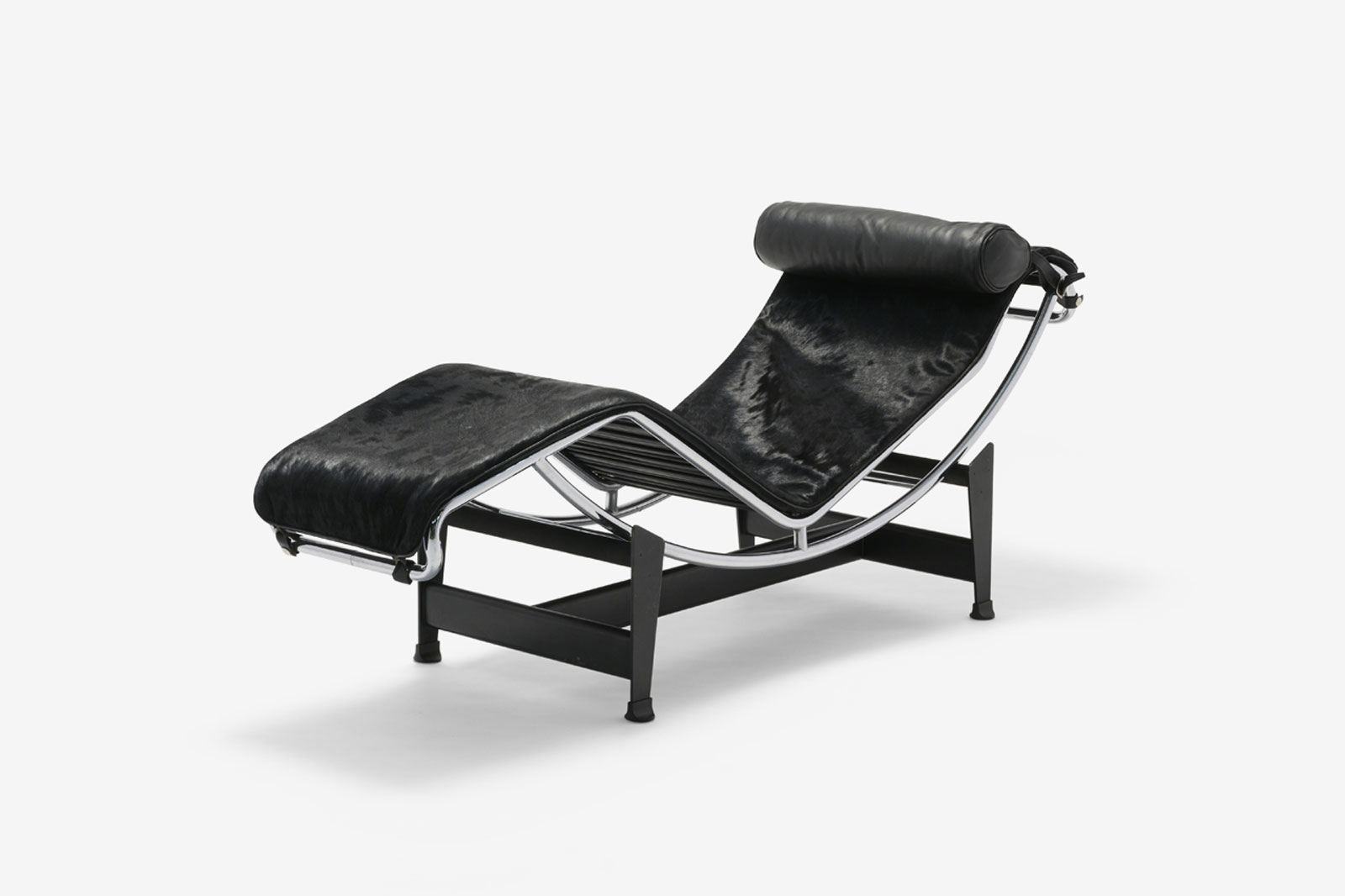
Le Corbusier + Pierre Jeannert + Charlotte Perriand
LC-4 Chaise Longue B-306 (1928)
The seat is mounted on a steel frame, and the rubber wrapped around the pipe supports the arc frame, allowing the seat angle to be changed smoothly. In addition to the current model, there is also a type with a welded pipe tip, both of which are in Oda Collection. A bamboo version designed by Perriand was introduced at Cassina a few years ago.
When I was newly married, I paid 10 times for salary deduction.
And when I finish paying, the second chair arrives.I bought this chair in 1972 when I was 25 and working in the advertising department of Takashimaya. I just got married and lived in a 2DK apartment. I got a 10% discount on this 300,000 yen chair sold at Takashimaya, and I used the “Tenchaku” from the employee discount which gives you additional 10% off. Moreover, it was possible to deduct salary in 10 installments. Even so, my salary was 40,000 yen and my rent was around 20,000 yen, so it was a big purchasing.
The LC-4 is the one I longed for in those days when owning a masterpiece chair was considered a status. There are many foreign interior magazines in the advertising department, and masterpiece chairs were listed as “status chairs” in Germany’s “SCHÖNER WOHNEN” and Italy’s INTERNI”. A chair is a support tool for the body, and at the same time it is a symbol of status. The head of an organization is called the “Chairman”. Wanting a good chair seems to be a manifestation of deep psychology. I’m not good at organization and I want to be free, so I don’t want to raise my status at all.
The department store buys furniture from overseas in order to hold overseas exhibitions. If it remains unsold, it goes on a bargain sale. Looking back on it now, the LC-4 was the first step toward aunt lion (laugh). It wasn’t even a year before I bought my second Pernilla (Bruno Mathsson).
When I was 27, my daughter was born, and when I was 30, my son was born. The LC-4 was covered with horse fur, so children used it as a slide to play on. One time, I received a bonus of 300,000 yen. At that time, it was cash payment, so I go home and give my wife an envelope. There were only 30,000 yen in the envelope. I had a big fight with my wife. It’s because I shop life this, but that’s why I worked outside the company until midnight every day to make money. But that wasn’t enough.
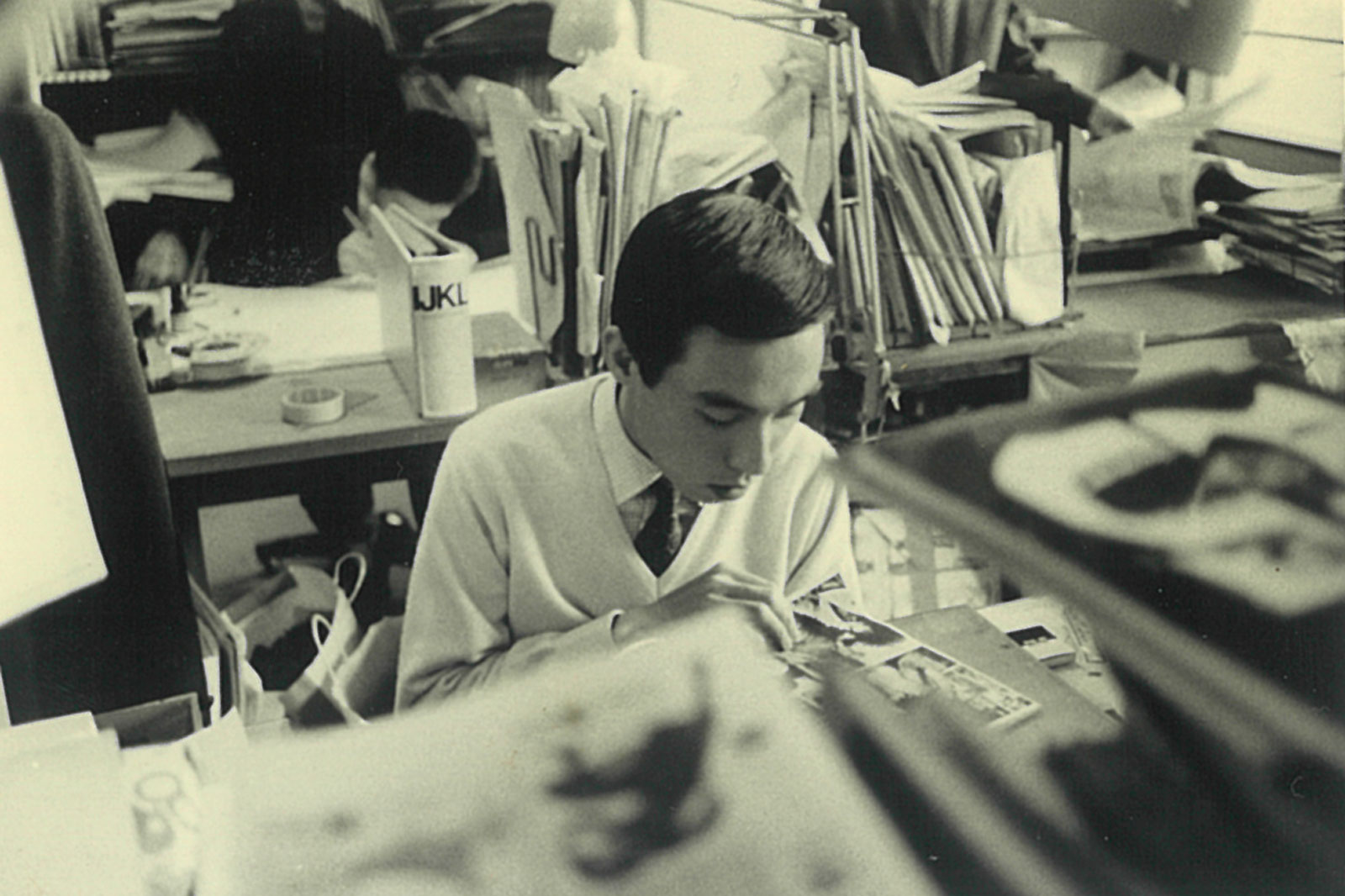
My seat in the Takashimaya advertising department. Taking advantage of the fact that the newcomer was on the aisle side, I drew illustrations, and my illustrations caught the eye of other teams and I got the chance to draw the Aramaki salmon for the main visual of the Hokkaido Products Exhibition. I should stop buying chairs.
I thought that too.When there were 7 or 8 chairs, I was satisfied with just using them myself. However, I bought a lot of interior-related books, so the room became too small, so I decided to move to a 2LDK one floor below the same apartment. But the number of chairs continued to increase, and when I reached 20-30, I purchased a 4DK apartment. Still, I had trouble finding a place to put the chair, and I had to ask my colleague to put it in their house. It’s also tough financially, and I’m always running out of money because I’m busy paying for chairs. Around this time, there was an incident that made me want to stop buying chairs. One day my kindergarten daughter had a fever. Even though I wanted to take her to the hospital, I only had about 100 yen in my wallet. I had a woman doctor who lived upstairs in the same apartment building make a house call, and it went all right. But when my daughter got well, I wanted the chair again.
I don’t know how many people have said to me, “I’m glad your wife stayed with you.” However, even in this kind of life, I buy almost everything my wife wants. I’ve been working hard and earning a decent income, and tried to atone for my wife’s troubles. Of course, the atonement continues even now (laugh).

This ascot shirt is from TORAYA, a men’s clothing store located in Osaka Minami Shopping Street. After that, I had a long relationship, such as having my shirt repaired until the sleeves and collar were worn out. Department store work and freelance, illustration and chair.
I’m always engaged in two trades at the same time.When I joined Takashimaya, I asked the company, “I want myself to be a part-time employee, not a full-time employee.” I wanted to avoid on-size-fits-all work, and I wanted to work outside the company to earn extra income. For example, as a regular job, I drew illustrations for a monthly economic magazine called “All Life”. The illustration in the article is 1,500 yen per point. I forgot about the cover fee, but for this job I used acrylic paint Liquitex for the first time. With the theme of “wrapping”, I drew a teapot, a sake barrel, and a red sea bream grilled in salt. I was looking forward to the monthly payment. I did not have an airbrush yet, so I drew all of them with a single brush, and I was happy that four of them were published in the yearbook of the “Society of Illustrators” (New York), which I admired when I was in college. Including these days, I seem to be a person who lives with “engaged in two trades at the same time”. Even after I opened my own illustration office, and even after becoming a professor at Tokai University, I have been doing research on chairs, so I was engaged in two trades at the same time.
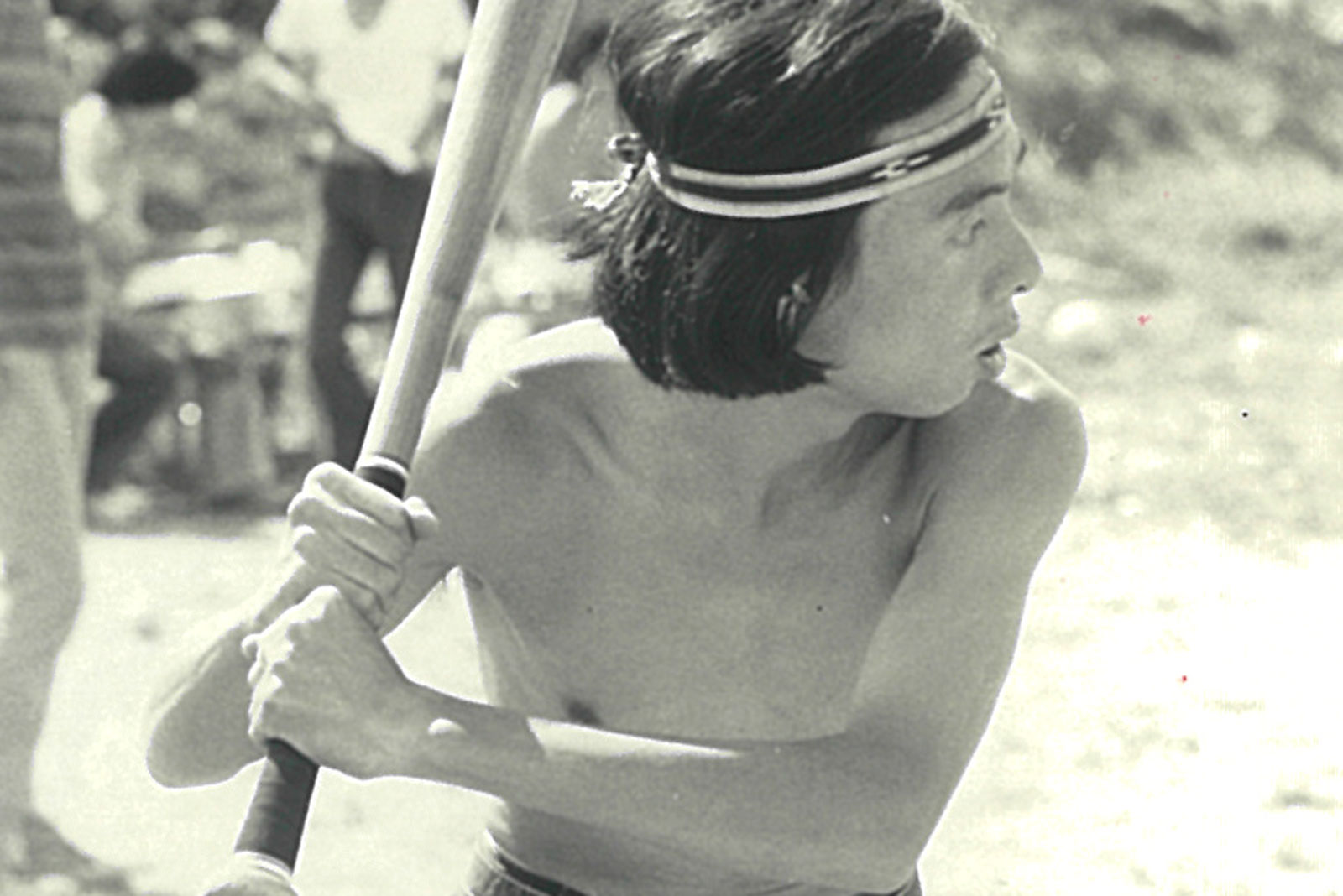
At the Takashimaya baseball tournament. At that time, I weighed 48kg (laugh). While being chased by the payment of dozens of chairs,
my life was healed by fishing and mountain climbing.In the 4DK apartment I bought, I raised about 700 fish. I collected sweet fish from Lake Biwa and put them in 12 tanks, ranging from large ones with a width of 180 cm to ones weighing 1 ton and small ones with a width of 60 cm. Oh yes, once when I cast a net to catch fish in the Yodo River, it got caught on the bottom of the river and I dived out. It was early April and it was night (laugh). A water change was a big job. You have to put tap water in after descaling. I went to a nearby pond with my children to scoop up small fish to feed the big fish and kept them in a separate tank. Eels and mozuku crabs escaped and went missing, and later the eels were mummified and the crabs came out of the fridge motor compartment covered in dust. It’s hard work, but for me who is busy with work, this was really comfortable time.
Speaking of comforting, there is another thing to do, mountain climbing. Of the 15 days off a year, including the New Year holidays, I took a five-day holiday once a year and traversed the Northern Alps. For that reason, I work without day off for several months, and about two weeks before climbing, I carried my child on my back and go back and forth up the stairs of the apartment to the 10th floor many times to get used to it. In those days, the roads and environment weren’t as good as they are now, so there were times when I got lost in heavy fog, I hurt my knee and dragged my feet down on the way from Mt. Tsurugi to Kurobe River and I finally reached my destination while lighting a match in a curved tunnel with no exit in sight.

The ever-increasing number of chairs fills my heart, but at the same time, my home becomes cramped. My interest in chairs was influenced by my father.
I have been a fish lover since childhood in my hometown of Kochi.I talked about diving in the river the above. I was born in a small town along the Niyodo River, which became a hot topic in the NHK special “Niyodo Blue” in Kochi, and I grew up surrounded by nature. I would dive into the river to catch sweet fish and eels, and sometimes I would give them to my mother who was running an inn, and received pocket money. My father was an official of the Imperial Household Agency, and later returned to his hometown to work at the government office, as a hospital manager, and as a Shinto priest. He liked furniture, and he always looked forward to coming to Osaka to see the furniture because there was nothing good in the countryside. When I was a university student (Osaka University of Arts), we used to look at furniture together at Yukawa Europe Land, the predecessor of Actus. A bargain chair by George Nakashima or Aalto was about 30,000 yen. It was an era when the remittance was 10,000 yen a month. So, my apartment didn’t look like a college student, with two Hidasangyo armchairs, a coffee table, a rocking chair, and a study desk and chair that my father ordered when I was in 3rd grade.
2002/9/1 At CentPure (Higashikawa)
Interviewer: Kano Nishikawa
[ After the interview ]
I’ve always thought, “I’d like to listen to some interesting episodes that come out while Mr. Oda explains the chairs.” When I met him this summer, I told him about it, and when I said to him, “Do you have the top 5 chairs that you had a hard time getting?” Soon after, Mr. Oda himself proposed to the Oda Collection Organization, which led to the realization of this series. The 1st time is definitely the LC-4, the first of over 1,400 chairs. I feel like I saw the magic of the Oda Collection (laugh) in the “how to buy” this chair and the “how to earn” that makes it possible. Even so, his love for beautiful things runs deep. From the next time, I would like him to show us a deeper story. (Nishikawa)
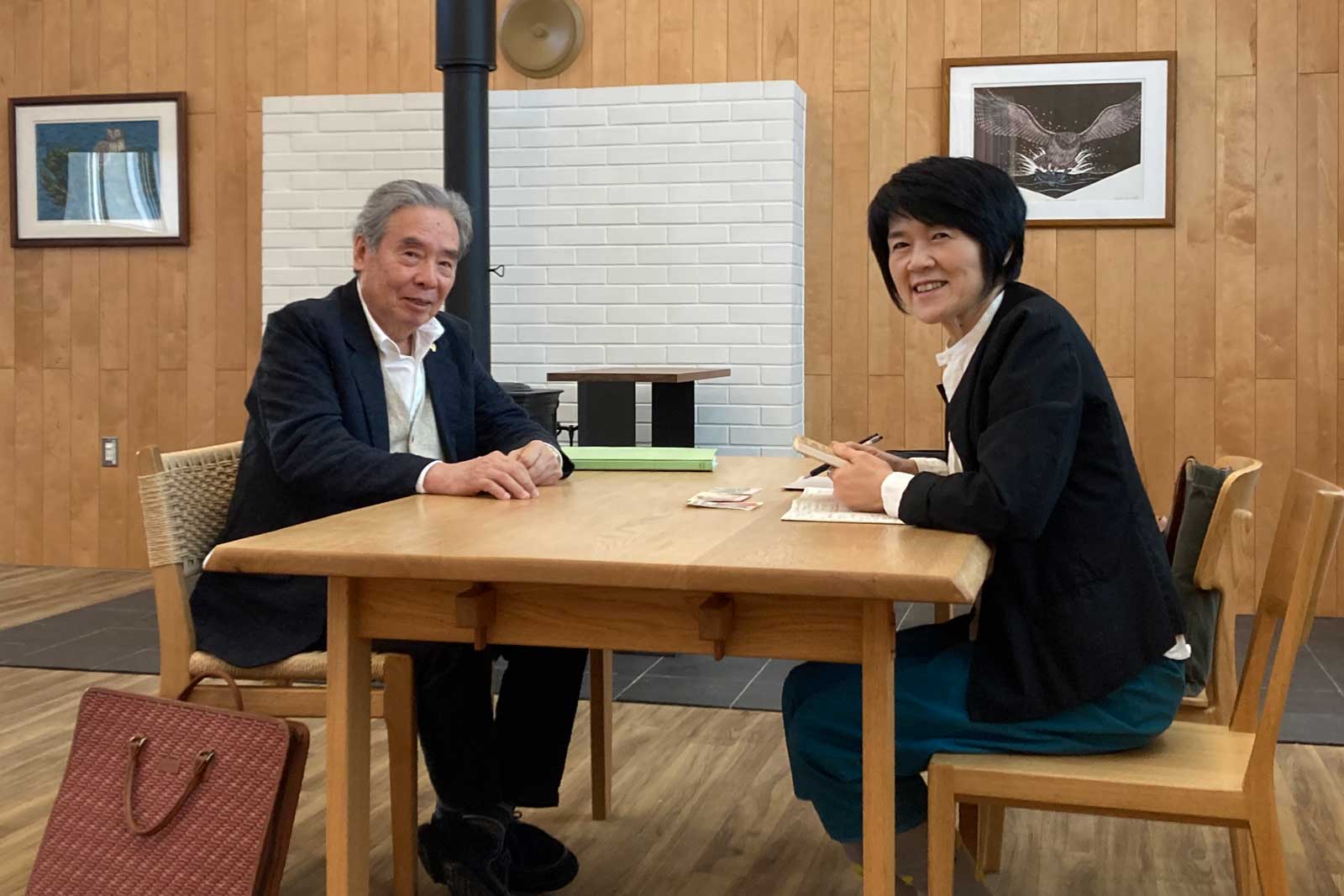
Copywriter Kano Nishikawa
After working at a design office in Tokyo and Sapporo, I started working as a freelancer in Asahikawa in 2001. Until now, I have been involved in the production of advertisements for local companies and organizations, including Asahikawa Furniture. I have known Mr. Oda for about 30 years through my work.
Category

